#those are all explicitly and extensively discussed in the video
Explore tagged Tumblr posts
Text
Research findings: How are people creating a sense of togetherness online?
The everyday inventiveness of translocal relationship maintenance
I'm excited to share some early insights from our latest study. Some of you may remember it from when it was distributed: a survey about how people who sustain relationships online create a sense of being in the same place, even at a distance.
Even now, online platforms are marching towards a future of standardised, formless, and profoundly placeless design. But relationships need place (Tuan, 1979), and people will continue to fashion new tactics to address their everyday needs. So, how do people in translocal relationships play with/around these technological limitations? How do they foster shared places on platforms that aren't designed for it?
That's what our study sought to uncover, and here's what we found...
---
Our deepest thanks to all who participated in the survey! We had 44 respondents—almost twice as many as we were hoping for—and more importantly, we got a pretty broad slice of translocal connections across the world:

Our original focus was on long-distance families and romantic relationships, mainly because people conventionally assume physical closeness and cohabitation in those relationships. But in practice, the data we gathered contained accounts of all kinds of relationships, so we expect the findings to be relevant (in varying degrees) to many kinds of online connection as well.
Across the data, a few themes showed up repeatedly, and through an extensive process of coding and clustering, we've distilled it into five themes, or key drivers of practices in virtual placemaking:
1. Synchronicity ⌚
People seek to act in concert and in temporal proximity, to feel a sense of relatedness—be that by experiencing media together, collaborating on a project, or just feeling collocated via a background voice call. Voice calls often scaffolded these kinds of synchronous activities—sound is a great vector for conveying simultaneity/"at the same time."
2. Persistence 📌
We talked about synchronous interactions above. Asynchronous interactions, on the other hand, assert the "being in the same space." This requires virtual spaces to not simply disappear or refresh when the session is closed: you're able to leave artefacts for others to discover even when you're offline or "in the background," and they accumulate over time. That's a core trait of a real place (as discussed in past research).
3. Emotional connection/depth 🫂
We know from other research that long-distance couples favour text messaging. Verbal communication is paramount in relationship deepening because it supports precise expressions of care and affirmation. But it can be asserted by other expressions too, like offers of help, favours and gifts—implicitly or explicitly indicating that one has the other person in one's thoughts, as well as their interests, well-being, and goings-on.
4. Physical linkage 🔗
Despite the focus on virtual spaces, many respondents saw great importance in anchoring their bonds in physical space, and used technologies as windows, or bridges, linking those spaces together. Using video calls as "windows" to have meals together, virtual house tours where the smartphone acts as a surrogate for the person on the other end, buying the same game board and playing against each other by replicating each other's moves...our data was replete with creative ways of bridging physical divides.
5. Co-creation 🖼️📝
Collaborative narratives and creation uniquely allow for interactors to explore and cohabit a shared mental place, in which they have an equal stake and are emotionally engaged. It's a way of being psychically co-present through roleplay and active imagination. Our data was full of mentions of collaborative creative work and narratives, from Dungeons and Dragons to building worlds together to making art of imagined alternate realities.
---
Other neat insights:
Rather than ever being confined to a single platform, almost everyone inhabited and interwove practices across different platforms/media types, each with its own utility, affect, and meaning: this is what Madianou calls "polymedia life." Think playing games on a virtual board while discussing it in a text chat, watching a show together on a streaming website while discussing it in a call, playing Wordle independently and checking in with the group chat to see what others thought, etc. This was almost universal across the dataset!
There were a lot of unique practices described in the dataset (i.e. instances where one respondent was the only person in the dataset who did that thing) - and yet it was never described as a practice we deliberately designed to solve a problem. This everyday inventiveness among people in translocal/transnational relationships has become the core of our research interest.
Lots of intergenerational connection (parent/child, grandparent/grandchild, aunt/uncle/niece) was evidenced - and a strong skew towards text chat, video calls, and voice calls for these. Video games are far more common among romantic relationships.
---
That's all for this post—I'll be back soon (very soon) to talk about what comes next.
66 notes
·
View notes
Text
I agree that I can't convince you that god is not real (it's startling that you don't believe in the concept of a patriarchy, but I would simply refer you back to all my statistics about violence against women, or encourage you to watch the news, but I digress). I have a problem when you make claims using your religion about the innate qualities of women, of which I am one. And it seems to me that the crux of your logic as to why I am inferior and should submit to men is that god tells you so. And I demand that if you are going to make claims about me based on your god, you must justify your god to me. Which I see you can't do, and that's okay. That just means what you're saying is wrong, and the reasons you're saying it are not ones that are grounded in any god but only in your own bigotry.
With that out of the way, let's turn to the video:
A lot of it was biographical but I think the crux of the argument you are trying to make by showing it to me is the Catholic idea of the theology of the body. Women are to have a lesser, submissive role in religion due to the bodies of believers being a metaphor (or a living representation) of the relationship between the bride and the bride-groom, or Christ and the church. The Christ being represented by the bride, and the bride-groom being represented by the church. And, by extension, women being represented as the bride and men being the bride-groom. That is the justification for women not being priests, not being involved in the church, being submissive to their husbands, etc. The physical bodies of believers are metaphors for the relationship to Christ.
A few problems with this:
The interpretation of gender roles is illogical, even if you believe it's ordained by god. Wouldn't women, who in this metaphor are closer to the divine vision of god than man, be in a much better position to lead congregations and understand god as a creator? Why have mass be an acting out of god's word, with the church (man) being a proxy for that knowledge, when women are by your own theology much closer to god metaphorically and in the power of creation? All this only convinces me that women should be venerated! They should be worshipped as vessels of god on earth and treated as divine vessels of wisdom and knowledge! But you want them to be submissive and not lead, ridiculous!
The theology of the body fails to explain why contraceptives or gay marriage is not allowed, both explicitly forbidden by the woman in the video. Wouldn't taking contraception simply be women taking control of their creative power? God flooded the earth to kill all of his 'children' he thought were evil, surely women taking control of their reproductive power through contraceptive and abortion would be analogous to that.
There is exactly zero evidence in the bible, or any other holy 'word', that this is how it is meant to be. The beginning of the video discusses feminist christianity, which was promising and hilarious that it seemed to lead directly to atheism, and dismisses it as reinterpreting the bible to suit the whims of angry (and overly suspicious) feminists. But show me the passage in the bible that says exactly what the theology of the body espouses, I bet that you can't. I bet all you can show me is a collection of disparate bible verses, written thousands of years apart, that were brought together and interpreted to mean what you wanted it to. By that logic I can make the bible say anything by playing black-out poetry with the New Testament. It's just as ridiculous an interpretation as 'feminist christianity' was to the speaker and guest.
But it comes down to the fact that I don't ask it to make 'rational sense'. I don't need it to. But I do know that whoever wants women and men to be at each other's throats. It isn't God.
How do you know what god wants? You are clearly uncomfortable with the literal word of god, but you are unable to justify your interpretations of those words. Men have been the greatest killers of women on earth, the god of the bible ordered the rape and enslavement of the female populations of dozens of settlements, how do you know god doesn't want men to continue to do that until the end of time? And if there is a possibility that this is the god you believe in, and worship, why do you believe in him?

235 notes
·
View notes
Text
Bo-Katan Kryze’s Age

Or rather, it’s not polite to talk about a lady’s age, except in this Lady’s case
How old is Lady Bo-Katan Kryze by the time she appears in The Mandalorian?
We don’t have a canon answer, but we can get pretty close. And yeah . . . it’s a weird answer. But it’s not without reasoning.
Though Bo’s exact age has not been explicitly confirmed, Bo-Katan is in her mid-60s by Mando S2.
How did I get to that conclusion?
1. Dave Filoni has implied that Bo-Katan and Satine are twins, or at least very close in age.
At least twice, Dave, who has said that he has an “extensive genealogy of Clan Kryze,” has referred to a formative event that happened in the Kryze family when "[Bo-Katan] and Satine are six.”
The first is in a YouTube video (source listed in reblog, or search YouTube for the title listed below)
You ask yourself why is [Bo] acting one way & why was [Satine] a pacifist? I have a theoretical backstory that outlines them even at six years old—the two of them—& what transpired to make them who they are today.
- Dave Filoni, The Clone Wars Hangout - February 2, 2013, start at 28:15
The second is in an interview with IGN (source listed in reblog)
I have a rather lengthy backstory that even explains how [Bo] became a Death Watch soldier that goes all the way back to the time she and Satine are six. Because to figure out how she got to that point, and yet Satine is a duchess… I have a whole story about who their father was and what their relationships were and everything with Vizsla, going back for a very long time and how that intersects with Obi-Wan Kenobi.
- Dave FIloni, IGN Interview, 2013
Both of these sources come from shortly after The Lawless aired in 2013. Yes, it is possible that Dave has since backtracked on this idea, however, until we know more, that’s unwarranted speculation (however, we’ll speculate on whether or not Bo could be younger than her mid-60s by the time of The Mandalorian later).
-
2. Bo-Katan (and Satine) are close in age to Obi-Wan Kenobi.
Even establishing that Bo and Satine are probably twins or close in age, we don’t have a canonical age for Satine in order to solidify how old they are. However, we do know that Satine is close in age to Obi-Wan Kenobi. They fell in love together while they were on the run together during the time that he was a padawan.
Because this is all we know, the reasoning behind Bo’s age has to rely on Obi-Wan birth (57 BBY). I’m willing to allow for a slight difference between Obi-Wan and Satine & Bo, but it can’t be much (especially since we know that Satine begins ruling Mandlore immediately afterwards). Thus, we’ll consider the difference basically negligible at this point, and just assume that Obi-Wan, Satine, and Bo were all born in 57 BBY.
That makes them 38 years old at the time of Satine’s death in The Clone Wars (19 BBY). Bo and Obi-Wan are about 56 when they appear in Rebels (1 BBY), and Bo is about 67 years old by the time of The Mandalorian Season 2 (~10 BBY).
So yeah. That’s definitely different from how Bo looks in Mando S2. Katee Sackhoff is 40 years old (about the same age as Bo in The Clone Wars), but they really did not try to age her up at all.
-
Could Bo be younger?
So, just for the sake of argument, could I be wrong about all this? Let’s say that Dave has backtracked on his original plan to have Bo and Satine be twins. Could Bo be younger? And by how much?
If Dave backtracks on them being twins, he’ll probably have to backtrack on the story that he had about something happening to Satine and Bo when they were six that had a formative effect on why Satine became a pacifist and Bo a warrior.
(Though it’s only speculation, I’ve always assumed that event was the death of their mother, so in my mind, Bo can’t be more than six years younger than Satine, but I could be totally wrong about that headcanon)
But let’s say that just for the sake of argument, Bo is quite a bit younger. Let’s say she’s 15 years younger than Satine, and that would make her a little older than 50 in The Mandalorian Season 2 (still over 10 years older than Katee). That means that she would have been about 23 years old at the end of The Clone Wars.
There’s nothing that concretely denies this, but we do know that Bo’s nephew, Korkie is about 18 at that same time (he’s listed as being in his “late teens” in Season 5, in the original novelization of The Lawless), and it’s just hard for me to believe that Bo is only five years older than him. She’s clearly much closer to Satine’s age.
Plus, making her that much younger robs Bo and Satine of a connection that they clearly had at one point. In The Lawless, Satine says that it’s been a long time since they’ve seen each other and that there was a time when the two of them weren’t enemies. Again, there’s nothing concrete here, but I’d have a hard time buying an actual enemies-life feud between them when, for example, Satine is 25 and Bo is 10.
Impossible? No. But personally, I just don’t think that’s what Dave is thinking about.
-
Was her appearance in Mando S2 intentional, or was Bo’s age simply forgotten/ignored?
As I mentioned, Katee Sackhoff is 40 years old, but they really did not try to age her up in The Mandalorian, even though Bo likely is in her mid-60s.
While this is strange, I do not believe that this is an oversight. Dave Filoni loves timelines, and Katee has said that between takes all they would do is sit together and Dave would tell her everything about Bo’s backstory and work through all the timelines with her.
So what could the explanation be? Well ... it could be an out-of-universe explanation. It could have been decided not to age Katee at all in order to make her as instantly recognizable as possible in live-action for those who already knew her from the animated shows (I struggle with this though, because some streaks of grey in her hair would not make her less recognizable, especially with that iconic armor).
However, there could be an in-universe explanation. Instead of having Katee play someone who looks like she’s in her mid-60s, Dave may have decided to have her play someone who doesn’t look like she’s in her mid-60s (but still is).
Some options include: 1. Canonizing the idea that was present in the EU that Star Wars humans simply live longer than regular humans (personally, I’m not a fan of this because we’ve never seen characters aging in a way different from Earth humans before, so I think it would set an awkward precedence).
2. Giving Bo herself a reason for why she looks much younger than her age. The one I’m most fond of is the idea that maybe for most of the time between TCW and Rebels, Bo was stuck in carbonite (perhaps by the Empire for some reason). 15 years in carbonite would allow her to be 65 but act as if she’s 50.
3. Hanging a lantern on the whole situation by saying that “wearing a helmet in the sun really keeps the wrinkles away!” or something like that. Bo’s in great shape. She’s led a healthy (if dangerous) life, but it’s not unheard of for people in their mid-60s to be very athletic. However, I do think that if that’s the fact, it still needs to be explicitly referred to.
-
Will we learn more in the future?
I sure hope so. Katee has basically confirmed that Bo’s story will be ongoing and she expects/hopes to be in The Mandalorian Season 3. It’s possible we’ll learn more about Bo’s backstory (including how old she is), and hopefully we’ll get an explanation for her appearance.
Katee has said that she desperately wants to know more about the story of Bo and Satine, and how Obi-Wan/Satine’s relationship affected Bo as well. Those are all things that Dave has expressed interest in exploring:
I’d give you more detail [about Bo and Satine’s backstory] except I’d like to tell that story at some point in some form of Star Wars media in the future. I’ve discussed it with a couple people, and we’ve started to architect it into the timeline of Star Wars somewhat, just to see where these things fit.
- Dave FIloni, IGN interview (2013)
So I’m just clinging to the idea that perhaps some day, we’ll be getting more answers. Bo’s appearance in The Mandalorian and bringing her story to a more general Star Wars audience certainly bodes well for more details on the Kryze family story in the future.
#The Mandalorian#Mando Season 2#The Mandalorian Spoilers#Spoilers#Mando#Bo-Katan Krye#Satine Kryze#Duchess Satine#Obi-Wan Kenobi#Obitine#Clan Kryze#Dave Filoni#Star Wars#The Clone Wars#SW#TCW#Star Wars Rebels#Bo-Katan#Lady Bo-Katan#Mandalore
234 notes
·
View notes
Text
On Ninian’s Paired Ending
Theoretically, because of what is established about Eliwood in The Binding Blade, it stands to reason that pairing anyone up with Eliwood in the prequel, The Blazing Blade, can be construed as knowingly setting them up for tragedy. There’s a small wrinkle, however, in that The Binding Blade was never released outside of Japan, while The Blazing Blade was (under the annoying title Fire Emblem), which means that in practice, non-Japanese players can’t reasonably be expected to know about Eliwood’s partner’s fate.
With one major exception: Ninian.
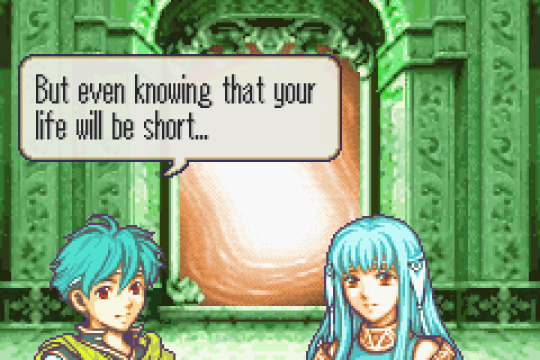
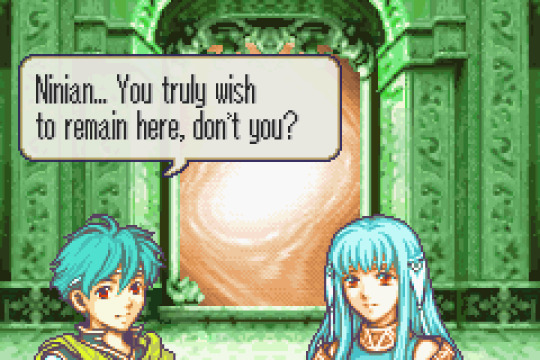
If you raise Eliwood and Ninian’s support level to A, the modified ending to the final chapter, “Light”, has Nils talk to Ninian and explicitly spell out, primarily to the audience, that neither of them will live long if they stay in Elibe. Despite this, sensing his sister’s wish to stay with Eliwood, Nils entrusts Ninian’s shorter life and happiness to Eliwood and says goodbye as he heads through the gate to live a long life, never to be seen again.
Now, granted, what exactly Nils means by “short” and “long” isn’t necessarily clear just in the context of this scene. Since it’s established that dragons live for millennia, you could reasonably interpet “short” as “short by dragon standards”, which could be still be very long by human standards. This read doesn’t hold up particularly well given further context, but just in the scope of what is presented in The Blazing Blade, it’s not patently ridiculous.
But that interpretation only deflects from the real tension at play. From Ninian’s perspective, she is trading away a long, happy life in another world with her brother for a significantly shorter, but potentially happier(?) life in Elibe with Eliwood. Whatever “short” might mean by human standards (including the player), it’s definitely short by Ninian’s standards.
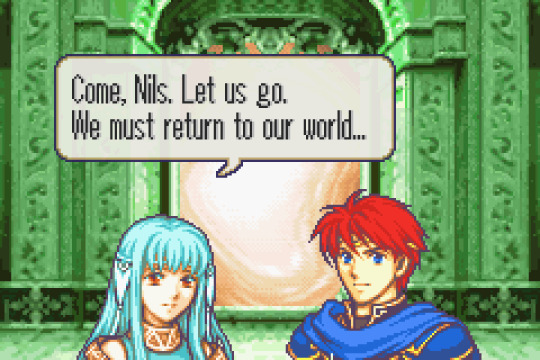
From an in-universe perspective, there’s no actual tension from this decision. Nothing in the text suggests that Ninian is making this choice out of anything but her own free will. In fact, Ninian was fully ready to leave alongside Nils and was saying goodbye to Eliwood, only stopping when Nils chimes in and essentially give her and Eliwood his blessing to stay.
The tension arises when viewing all of this from a meta perspective; namely, that the writers saw fit to make this Ninian’s fate. Even as someone who likes the pairing and likes the way it plays out, because it’s effectively setting an angst time bomb, I’d be lying if I said this narrative beat felt... questionable. Like, Ninian is a character developed enough to have an identity outside of being one of Eliwood’s love interests (see also: her relationship with Nils, her other supports with Hawkeye and Florina), but making her final major act of agency be consigning herself to a brief life with Eliwood doesn’t exactly instill confidence that she actually is more than Eliwood’s love interest.
None of this, on its own, is all that noteworthy. What is noteworthy, however, is that everything I just mentioned is contingent entirely on raising Eliwood and Ninian’s support level to A. Since Ninian is only available for deployment (and, by extension, for developing supports) for seven or eight out of over thirty chapters, and Eliwood must not have more than two support conversations with other characters, this is actually quite difficult to do intentionally, let alone accidentally. If Eliwood and Ninian do not have an A-Support, then Ninian leaves with Nils as she intended to, and quite likely lives a long and happy life with her brother.
As such, knowledge of this ending imposes a special dilemma on players who do like Eliwood and Ninian together. Do you manifest their pairing in your game, etching their union into the personal canon of your save while also ostensibly dooming Ninian to a simultaneously canonical early death? Or do you instead leave them unpaired, saving Ninian in the personal canon of your save while avoiding leaving any canonical trace that the two could even be happy together and settling for other, external ways to express your preference?

I’d wager some people don’t actually see this as a dilemma, since it’s contingent on placing what they would see as undue focus on canon, and all that matters is what is expressed to the outside world, to others, which most commonly takes the form of fanwork. Whether or not the ending is actually achieved, the shackles of canon can only weigh down those that respect it, and it’s trivially easily to pick and choose as needed. What’s the issue?
And while I am ultimately of that mindset, I also think it is useful to at least sometimes take canon as it is and properly think through the implications, however inconvenient or unpleasant they might be. Canon, after all, is only what is assumed to be the common ground for all participants, so it’s at least worth thinking about how things would have to play out canonically, if discussing works of fiction with other people is something to be valued.
I bring this up as someone who’s been sitting on an Eliwood/Ninian fic that tries to explore how Ninian (and to a lesser extent, Eliwood) would go about living in the time between The Blazing Blade and The Binding Blade, with the knowledge that she’s not long for the world perpetually lingering over the two. It’s something I’ve been thinking about ever since I learned about the way the pairing plays out in The Blazing Blade for the reasons highlighted above. Doomed relationships are nothing new in video games, but this specific kind of doomed relationship, where actualizing it necessarily brings about an otherwise avoidable death, is considerably rarer.
It’s not all that surprising that I personally would take to it, since it’s an obvious wellspring of angst, but it’s one that requires some legwork to really hit. It’s one thing to die, mourning for a potential that was never realized; it’s another (and in my opinion, more gutwrenching) thing to actually realize that potential then fade away, believing wholeheartedly that it was all worth it in the end.

Canonically speaking, if Eliwood and Ninian were to be together, it could only ever be for a few years. And through her actions, we, as an audience, are to believe that spending a few years with her beloved Eliwood would make Ninian happier than spending many years amongst her kind in another land would.
And as someone who on some level wants the two to be together, I feel at least some obligation to try to imagine a life where that holds true, in my own small way, even if such a life is bound to end in tears.
#ninian#eliwood#fe7#blazing blade#the blazing blade#fire emblem the blazing blade#elinini#angst#fanfiction#fanfic#canon
51 notes
·
View notes
Text
“...We can dispense with the first question fairly quickly: is violence the supreme authority from which all other authority derives in actual societies? After all, we keep encountering historical models predicated on that premise and they keep being pretty bad, inaccurate history. But even shifting from those specific examples to a more general appraisal, the answer is pretty clearly no. Reading almost any social history of actual historical societies reveal complex webs of authority, some of which rely on violence and most of which don’t. Trying to reduce all forms of authority in a society to violence or the threat of violence is a ‘boy’s sociology,’ unfit for serious adults.
This is true even in historical societies that glorified war! Taking, for instance, medieval mounted warrior-aristocrats (read: knights), we find a far more complex set of values and social bonds. Military excellence was a key value among the medieval knightly aristocracy, but so was Christian religious belief and observance, so were expectations about courtly conduct, and so were bonds between family and oath-bound aristocrats. In short there were many forms of authority beyond violence even among military aristocrats. Consequently individuals could be – and often were! – lionized for exceptional success in these other domains, often even when their military performance was at best lackluster.
Roman political speech, meanwhile, is full of words to express authority without violence. Most obviously is the word auctoritas, from which we get authority. J.E. Lendon (in Empire of Honor: The Art of Government in the Roman World (1997)), expresses the complex interaction whereby the past performance of virtus (‘strength, worth, bravery, excellence, skill, capacity,’ which might be military, but it might also by virtus demonstrated in civilian fields like speaking, writing, court-room excellence, etc) produced honor which in turn invested an individual with dignitas (‘worth, merit’), a legitimate claim to certain forms of deferential behavior from others (including peers; two individuals both with dignitas might owe mutual deference to each other).
Such an individual, when acting or especially speaking was said to have gravitas (‘weight’), an effort by the Romans to describe the feeling of emotional pressure that the dignitas of such a person demanded; a person speaking who had dignitas must be listened to seriously and respected, even if disagreed with in the end. An individual with tremendous honor might be described as having a super-charged dignitas such that not merely was some polite but serious deference, but active compliance, such was the force of their considerable honor; this was called auctoritas. As documented by Carlin Barton (in Roman Honor: Fire in the Bones (2001)), the Romans felt these weights keenly and have a robust language describing the emotional impact such feelings had.
Note that there is no necessary violence here. These things cannot be enforced through violence, they are emotional responses that the Romans report having (because their culture has conditioned them to have them) in the presence of individuals with dignitas. And such dignitas might also not be connected to violence. Cicero clearly at points in his career commanded such deference and he was at best an indifferent soldier. Instead, it was his excellence in speaking and his clear service to the Republic that commanded such respect. Other individuals might command particular auctoritas because of their role as priests, their reputation for piety or wisdom, or their history of service to the community. And of course beyond that were bonds of family, religion, social group, and so on.
...So while it is true that the state derives its power from violence (as in Mao’s famous quip that “Political power grows out of the barrel of a gun”), the state is not the only center of authority within a society. And indeed, even the state cannot run entirely on violence; this is the point that Hannah Arendt makes in the famous dichotomy of violence and power. In many cases, what Heinlein’s premise does is mistake violence for power, assuming that the ability to violently compel action is the same as the power to coordinate or encourage action without violence. But in fact, successful organizations (including, but not limited to, states) are possessed not of lots of violence but of lots of power, with much of that power rooted in norms, social assumptions, unstated social contracts and personal relationships that exist entirely outside of the realm of violence.
And so in both theory and practice, Heinlein’s premise fails to actually describe human societies of any complexity. There are no doubt gangs and robber-bands that have functioned entirely according to Heinlein’s premise (and presumably some very committed anarchists who might want such a society), but the very march of complex social institutions suggests that such organizations were quite routinely out-competed by societies with complex centers of authority that existed beyond violence, which enabled specialization (notably something Heinlein disapproves of generally, ‘specialization is for insects’) and thus superior performance both in war and in peace. Kings and empires that try to rule purely with force, without any attention paid to legitimacy or other forms of power (instead of violence) fail, and typically fail rapidly. As with almost any simple statement about complex societies, Heinlein’s premise is not merely simple but simplistic and so fails.
...The Cult of the Badass, as expressed here, lives in what we might call the “cult of tradition,” “dreaming of a revelation received at the dawn of human history” about a certain set of warrior values which were both expressed by famous historical warriors and which now provide a blueprint for life. This point of explicit in Pressfield’s set of videos, and implicit in the Fremen Mirage’s strong men/hard times model of history. This “cult of tradition” is quite selective, of course; Pressfield makes functionally no effort to engage with actual ancient value systems in a sustained way, limiting himself mostly to ‘badass’ aphorisms from Plutarch (himself hardly the most intellectually sophisticated or morally challenging author in the classical canon). It is tradition as imagined dimly in the present, not tradition as uncovered by careful historical research.
Consequently, the cult of the badass must engage in “the rejection of modernism;” this is no accident because the cult of the badass is an “appeal to a frustrated […] class” – this too is explicit in that Pressfield frames his ideology was a way for individuals who are held back or stagnated to unleash their true potential and overcome their limits, through the explicit rejection of modern values and the embrace of what are at least presented as traditional, even timeless values. That sort of appeal is also explicit in a lot of the fitness marketing that trades on the cult of the badass (and it seems notable that Pressfield himself lists “anybody that is heavily into fitness” first among his people living out the ‘warrior archetype.’), calling on people to work out like the Spartans. Consequently, it is a “cult of action for action’s sake” often focused on doing rather than asking what should be done (it is striking that Pressfield, despite nearly all of his video examples coming from the Greek and Roman world, engages not at all with the extensive Greek and Roman philosophies of justice).
Instead, this ideology, because it positions the capacity for violence as the highest human value, presents the thesis that “life is lived for struggle.” Pressfield reframes all of life’s struggles, including struggles of motivation and self-discipline, in terms of violence, in terms of a war against the ‘inner enemy,’ and consequently “life is permanent warfare.” And I think this goes a long way to explaining the obsession of this philosophy on warrior elites, because there is an inherent element of “popular elitism” in the cult of the badass, an insistence that at least it should be the case that “everybody is educated to become a hero” and thus not only develop the capacity for violence but also orient themselves towards “heroic death, advertised as the best reward for a heroic life.”
Thus the outsized influence of Thermopylae, a ‘heroic’ Greek defeat over other battles; Pressfield, again, is explicit on this point that it is at Thermopylae in particular that the Spartan warrior ethic is best and most perfectly displayed. If these are held to be the highest ideals, then anyone who falls short of them or refuses to engage with them must be weak, perhaps even “so weak as to need and deserve a ruler” (a point that often emerges in the sheep/wolves/sheepdog metaphor used by many ‘warrior cops,’ an ideology Pressfield explicitly appeals to, lumping in law enforcement as exemplars of ‘warrior’ ideology).
And of course, as is I think obvious in these readings, there is an undercurrent of anxiety about masculinity here. It is, after all, strong men in the strong men/hard times trope (and that is no accident as the trope is deeply connected to concerns about masculinity throughout its history). ...While Pressfield insists in some of his videos that his life philosophy is equally applicable to men or women, it is hard not to notice that his historical examples of warriors are all men (no Molly Pitcher, no Deborah, no Hua Mulan, etc. Not even Empress “Imperial Purple is the best burial shroud” Theodora; he does discuss the legend of the Amazons with rather less historical rigor than I might like). Where actual historical women fit in to his narrative, it is mostly as the mothers and nurturers of warrior men. While Pressfield does his best to paper over this (and to be fair, I think he is sincere in trying to present his ideology as non-gender-specific, unaware of the ways in which the broader framework of that ideology is aggressively unwelcoming to women), I think it is fair to say this is an ideology created largely by and for men, which values a hypermasculine ideal – we might even say “machismo.”
And by now readers are beginning to wonder where all of these little quotations are coming from (apart from the bit from Theodora). But first I want to note that we have a name for an ideology that fits these main points – where “life is permanent warfare,” “lived for struggle”, such that “everyone is educated to become a hero” to participate in a “cult of action for action’s sake” in a “cult of tradition” seated in a “rejection of modernism.”
And it’s fascism. Because all of those little quotes are from Umberto Eco’s famous essay “Ur-Fascism” (1995) which presented one of the most compelling classifications of the foundational DNA that all of the various, disparate forms of fascism share in common. ...Now I think it is important to back up here and be fair to Steven Pressfield. I don’t think Steven Pressfield is a fascist; ...What I do think is that the ideology that Pressfield is advancing has fascist tendencies (that he is, I suspect, unaware of, having not interrogated the nature of Spartan society as carefully as he might have). The ideology he is advancing shares most of the DNA of Ur-Fascism and it is not hard to see how the remaining handful of elements might easily be bolted on to this framework.
It is also, in a way that Pressfield never really addresses (and I suspect has never really realized), an ideology which is fundamentally at odds with the democratic values he also holds. If only some people are ‘warriors’ and developing that warrior capacity towards violence it the primary or principle virtue, it follows – and literally any Spartan could have and would have told Pressfield this – that everyone else is merely fit to be ruled. Sparta’s brutal oppression was not incidental to its ideology or social structure (as we’ve discussed!) but essential to it. As Eco points out (in his 10th point), it does no good to suggest that everyone ought to be equally a warrior; this is after all a cult of violence for its own sake and in violence there must be winners and losers. No complex society is composed only of warriors; for there to be kings and knights, there must be serfs too.
...Put more bluntly, the ideology of the Cult of the Badass is so easily falsifiable that the act of disagreement itself, rather than the content of arguments, must be rejected). The rejection of disagreement in turn demands the fear of difference because the ideology requires consensus and an absence of criticism. And once the ideology fails – and it will, because it is disconnected from the real world – conspiratorialism is the natural response for true believers unwilling to reject the ideology. If your ideology tells you that you are superior, and yet you do not produce superior results, what recourse is there but to conspiracy? As Eco memorably quips, “Fascist governments are condemned to lose wars because they are constitutionally incapable of objectively evaluating the force of the enemy” which is also, by the by, why so many authoritarian armies, theoretically filled with supposedly highly motivated, ultra-badass super-soldiers, tend nevertheless to lose more than they win. We saw this with Sparta; the very ideology of the place made them bad strategists, in precisely the ways that Eco suggests it would.
In short, the ideology of the Cult of the Badass – which is easy to see in any number of modern films, books and TV (and occasionally read into films that explicitly reject it by their viewers; I suspect everyone of at least a certain age has known that guy who watched Fight Club and then wanted, entirely unironically, to start his own fight club) – is a gateway to authoritarian thinking which, contrary to the name, is based in violence rather than authority. The supremacy of action, of violence, of the warrior and his ‘ancient’ (but actually quite modern) values are the foundation stones on which fascist ideologies (and I’d argue, other non-fascist authoritarianisms, but that’s a debate for another day) are constructed.
And, as Eco notes, “The Ur-Fascist hero craves heroic death, advertised as the best reward for a heroic life. The Ur-Fascist hero is impatient to die. In his impatience, he more frequently sends other people to death.” This is not a good ideology. As I noted in the first post in this series, a free society has no need for warriors. Not among its soldiers, not among its police, not among its civilians. At times, a free people may need to become soldiers, or police officers, but always to return to being civilians again, either at the end of the day or at the end of the war.”
- Bret Devereaux, “The Universal Warrior, Part III: The Cult of the Badass.”
#the universal warrior#the cult of the badass#ur-fascism#bret devereaux#history#writing#warfare#ancient#medieval#greek#roman#spartan
8 notes
·
View notes
Text
Evidence for ADHD Marinette
Marinette has some tendencies in the show - that she does over and over again - that scream ADHD to me. Obviously I can’t cite every single instance in the show that points toward that, but here are some examples of ADHD traits/symptoms Marinette repeatedly exhibits on screen.
Forgetfulness, Time Management
Forgetting things. A hallmark of ADHD.
Let’s look at Timebreaker. Mari was all set to do her homework and wait for her parents’ client, completely forgetting that she was supposed to bring a banner for a race between her friends Kim and Alix - across town. Alya calling her at all didn’t even remind her, she had to be told explicitly what was happening before she remembered. Then proceeded to freak out because she’d accidentally made two commitments at the same time.

Marinette completely spaced on the race, even though it was important to her, because there was something else right in front of her: homework, her parents’ anniversary, and the Eiffel Tower cake. She was then certain that she could make it to the race and still be back at the bakery to meet Mrs. Chamack - which was a resounding NOT for anyone who watched the episode. The only way she got away with it was by literally being in two places at once. ADHD often comes with a bad sense of time, so while 20 minutes probably felt like enough time to Marinette it passed way more quickly than anticipated.
Forgetfulness, Distractability
Ah, another instance of Alya reminding Mari of her plans. In this case she’d lost track of time because of the Adrien ad playing on a loop on her computer - to the point that she was still not dressed even though all her friends were out and about (including the ones waiting for her at the pool).

As soon as she realized she was very late, Mari grabbed her stuff and sprinted out of her house without changing out of her pajamas. Even when Tikki told her she was forgetting something she’d jumped to the wrong conclusion - although she may very well have forgotten both her swim suit and to change.

Impulsivity, Creativity
Marinette improvises all the time. And she has a habit of diving headfirst into dangerous, crazy plans. The girl was facing down a T. Rex headfirst in Animan, and when she got her lucky charm her weird, creative problem-solving skills told her to jump into its mouth and jam it open.
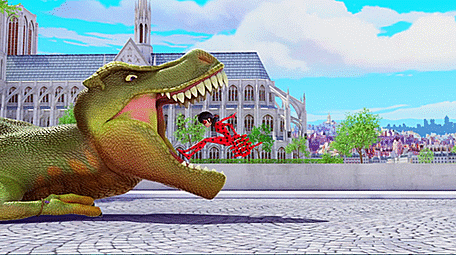
In general, I think her use of the lucky charms indicates a wild creativity that’s characteristic of ADHD. Current research shows a very high correlation between ADHD and creative personalities, and Dr. William Dodson (who has been studying ADHD for 25 years) has found that “by the time most people with the condition reach high school, they are able to tackle problems that stump everyone else, and can jump to solutions that no one else saw.”
Marinette exhibits this surprising and unorthodox problem solving when she spots a series of seemingly unrelated objects that will somehow end the fight. Take Copycat for example. She got a freaking SPOON and she decided to make it into a homemade fishing rod to hoist the fake Chat Noir into the air by his belt. WHAT EVEN
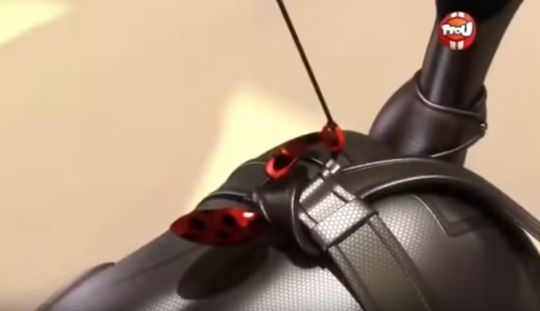
more Impulsivity
Even before she got comfortable in her skin-tight supersuit, Marinette did demonstrate an inclination to take impulsive risks in the origins episode. Master Fu tested her by deliberately walking in front of a moving car to see if she’d save him.
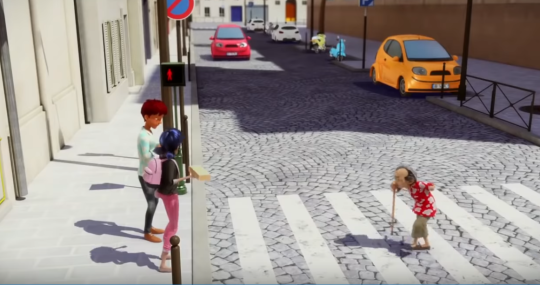
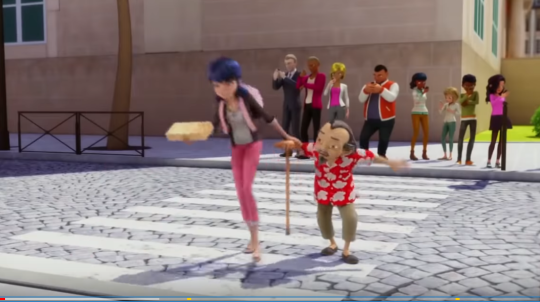
There was no hesitation here. She saw Fu, saw the car, and immediately ran out to pull him to safety. The whole thing happened in a few seconds. Obviously this action was motivated by her inherent kindness; she didn’t do a dangerous thing because it was dangerous. Plenty of good people (none of whom seemed to be at the crosswalk that day, they all noticed nothing) would have wanted to do something but hesitated, or not reacted in time.
Not Marinette. While she was clearly scared for him, the high stakes of the situation didn’t faze her; she just acted instinctively. According to Dr. Dale Archer, ADHD brains do well under pressure, because high-stress situations get the dopamine flowing and those levels make them snap to attention.
Time Management, Impulsivity (again)
In Lady Wifi, Marinette ran into class late for no indicated reason, something she does frequently (and only sometimes it’s because of Ladybug duties) to the point where her chronic tardiness becomes a running gag. This is an extension of her inability to judge time accurately as discussed above.
Also demonstrated in this episode, ADHD’ers will often have outbursts and accidentally say things without thinking. Upon learning what happened to Alya from Nino, she lost control and shouted “What?!?!?!” not once, but TWICE. It could also allude to emotional dysregulation (a less-known ADHD symptom) because she was unable to keep her emotional reactions to her friend getting in trouble under control.


Hyperfixation, Emotional Dysregulation
Hey, remember when Marinette was so absorbed in that Adrien ad that she forgot about her friends and her clothes? I think the Adrien video hit her with a double whammy, because she’s deeply infatuated with him and this new thing about the guy she likes ensnared her attention.
So Marinette is obsessed with Adrien, right? I’m sure most of us would fawn over a new ad starring our crush-who’s-also-a-model. But she has a one-track mind when it comes to him. Hyperfixation is an extremely intense obsession and focus on a subject, and I think her crush can qualify because it tends to dominate her life and attention. While many things may be difficult for Marinette to maintain focus on, ADHD is great for focusing on things that are interesting, challenging, and new. So when that beautiful ad showed up, this new thing related to her fixation pushed all the happy dopamine buttons in her brain. She obviously finds Adrien interesting because she’s interested in him, and she keeps trying to get him to notice her romantically and that’s definitely a challenge.

If you’d like/need another example of Marinette hyperfixating on something, I give you: fashion. Okay, maybe that’s more of a passion than a fixation, but the episode Mr. Pigeon DID give us a hyperfocusing Marinette when she spent hours and hours on end designing and making the derby hat for Gabriel Agreste’s competition.
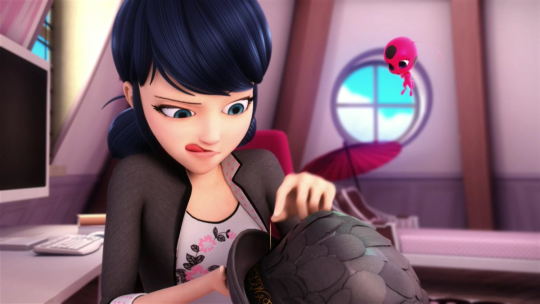
Moving on to emotional dysregulation. We’ve seen Marinette overreact to Alya being mistreated in Lady Wifi. Even casual watchers of Miraculous will know that Marinette has similarly powerful reactions to feelings and events concerning Adrien. I can’t even begin to count the number of times she's screamed around him.
Remember that time she publicly yelled at Lila in Volpina? Her jealousy and annoyance at her lies completely dictated her decisions here and she went way overboard - as Adrien was quick to tell her. She laid into her. NOT normal behavior for Marinette when she has her head on straight. Tikki sure wasn’t supportive of Marinette using Ladybug like this.
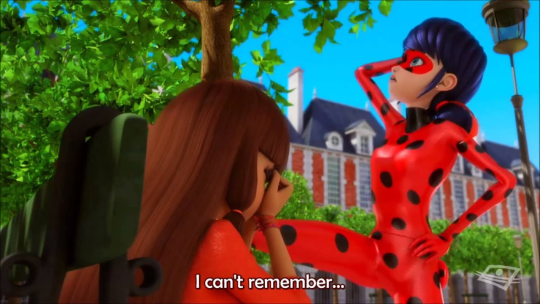
Tikki also wasn’t too pleased when she used her lucky charm to break up Adrien and Chloe slow dancing at his birthday party. This is another time her jealousy overtook her.
And one more little overreaction here. In Copycat, Marinette was totally spiraling in true melodramatic fashion about the consequences of stealing a phone. She imagined a life sentence. This is characteristic of how ADHD’ers often have trouble regulating emotions, leading to overblown responses to various stressors. Is it just me, or does she get particularly worked up when she’s fantasizing (both good and bad)?
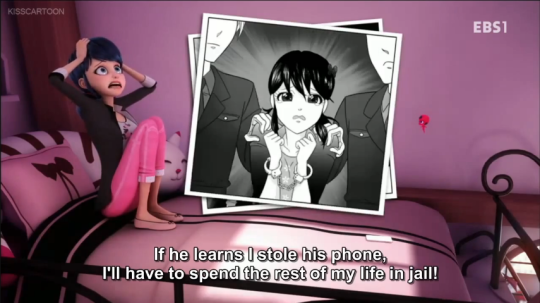
I can’t find a picture for it, but another time Marinette was reacting very strongly to a predicament was in Mr. Pigeon when she paced back and forth, flipping through her sketchbook, and ranted at Alya about how difficult a derby hat design would be. She was pretty disheartened by her lack of immediate inspiration; she was even curled up on the bench dejectedly while Alya tried to help her.
It’s also worth mentioning that she totally ran into a wall after Adrien complimented her drawings.
I could add more, but this post is already basically an essay and I think you get the point. If you share the ADHD Marinette headcanon do please add any examples you think of!
#adhd#adhd marinette#marinette dupain cheng#marinette#marinette dupain-cheng#master fu#ml#mlb#miraculous ladybug#tales of ladybug and cat noir#cat noir#chat noir#alya cesaire#alya#time management#hyperfixation#hyperfocus#impulsivity#impulsive#creative thinking#problem solving#emotions#emotional#emotional dysregulation#forgetfulness#I did so much citing for this#citations#so many citations#college has really gotten to me guys#marinette headcanon
3K notes
·
View notes
Note
hi there! i really appreciate the resources on clobber claims, but something i still can't really explain is passages that refer to marriages as being husband and wife, for example ephesians 5:22-33 - if husband and wife is the only model of marriage that the bible talks about in this way, how could it be applicable to all marriages (ie. same gender marriages)? 1/2
(2/2) and by extension, if the way marriage is talked about is not inclusive of all marriages, wouldn’t it mean same gender marriages aren’t included/accepted? sorry if i’ve worded it in a rather strange way, i’m not sure how to frame my question and i’m just kind of confused about it all. thanks ever so much and God bless you!
____
Hey there, great questions!
My quick response is:
the Bible was written in cultures much older than and utterly different from our own. Our concept of marriage doesn’t directly translate into anything depicted in the Bible. Plus, some things that exist now didn’t exist back then (cars, phones, terminology like “LGBT” or like “Christianity”) – so just because the Bible never explicitly mentions a certain thing doesn’t mean it condemns that thing, you know?
One thing that this means for me at least is that I need to constantly challenge my own assumptions about which kinds of relationships are “valid” or not in God’s eyes. What about polyamorous ones? Ones that involve sex without marriage? Marriages or other forms of committed partnership that don’t include sex?
My longer answer is below!
__________
I’ve got a post that responds to the question: The Bible’s passages on marriage are only about man+woman couples – so does that mean it condemns same-sex marriage? In that post you’ll find….
a link to another post that discusses what sexuality and marriage were “like” in biblical times – for instance, the concept of marriage as we know it today did not really exist in the time of the Hebrew Bible (“Old Testament”)! The closest thing that did exist was more like an economic agreement in which the woman was like property – it wouldn’t have made much sense for a two-man or two-woman relationship.
examples of stories in the Bible that actually do something somewhat like a marriage between two men, or between two women
Check out this post for even more – responding to the question “What does God consider marriage?”
________
Next, I said at the start of this post that just because something’s not mentioned in the Bible doesn’t mean it’s rejected by the Bible / by God. I want to note that the reverse is true as well: just because the Bible does discuss a thing doesn’t mean its authors and/or God affirms that thing – the Bible’s full of stories of attempted genocide, sexual violence, sexism, ableism, and more; but that doesn’t mean God condones those things! (If you’re interested in a book that delves into the various forms of violence in the Bible and what we should make of it, I recommend Inspired by Rachel Evans.)
The post I linked up above about biblical marriage describes how the closest thing to our concept of “marriage” in the Bible is more of a business transaction between men – usually the father of a woman and the man who wants to take her as his “wife" (or concubine, sex slave, etc. Yes, ew.) Just because that’s the model of marriage described in the Bible doesn’t mean God wants our partnerships to be like that! These things were just part of the “landscape” of the time and place the Bible was written.
Even when the authors of scripture seem totally content with those models or concepts, or even affirm and build off them like Paul does for marriage in that Ephesians passage you mentioned, that’s not still not a reason in itself to conclude that God also affirms them.
One can hold that the Bible is divinely inspired without concluding that that means that every viewpoint expressed in it is itself the “divine opinion” – human authors penned the Bible’s various books, and necessarily brought their human limitations and assumptions to that writing. Ephesians 5: 22-23, for instance, supports the marriage model that was normative in Paul’s day and that he therefore assumed was moral or “correct” – one in a marriage is necessarily between a man and a woman and contains a hierarchy, wherein wives are subject to / submit to their husbands. But is that really what God wills for our relationships? For explorations of that question, see this post on women in the Bible! And if you want even more to read, see this post too.
________
With all of this in mind, you might be wondering – so, is there anything in the Bible that can helpfully inform our marital relationships today? I think so!
People who consider the relationship between Adam and Eve to be a sorta paradigm for marriage should know that Eve is Adam’s equal, any idea of her subordinate status comes only after the Fall corrupts human relationships
As one of the linked posts above discusses, relationships between characters like Jonathan and David might could teach us some things about marriage
My wife and I once made a video on the concept of “complementarianism” and how the way it’s usually taught is super sexist and homophobic but maybe it can be reworked into something more LGBT-affirming.
…And honestly, if nothing else, some of the relationships we see in scripture might be examples of what not to do in a marriage (or any romantic/sexual relationship). We can study some of the relationships in the Bible and consider how they bear good or bad fruit, and take on or avoid characteristics of those biblical relationships in our own relationships.
Finally, one more post that might help as you continue to explore this topic – how to we take cultural context and human authors’ limitations into account without simply using the Bible to justify our own views; and if God affirms LGBT persons why is it so hard to “prove” it?
Good luck, and please let me know if you have more questions!
31 notes
·
View notes
Note
i just saw someone reblog your post that was kind of outlining something you wanted to write about the reflection of what porn means about society and i would love to read that. you're absolutely correct that most analysis of porn and society come from swerfs and terfs and they're absolutely terrible if you look beyond surface-level anything. oh but also please never make me read the phrase "regular degular people fornicating" ever again lol
So…thank you for waiting. The first thing I’d like to say is…*clears throat*
TERFS/SWERFS absolutely suck and their awful rhetoric and invasive presence obstructs discussion of women’s right. TERFS are the footwomen of the patriarchy and absolutely brainwashed, useless voices.
Now that that has been said…
Regular degular poeple fornicaiting. :D
Okay enough silliness, here’s my point. Usually critique of porn comes in two main flavors: “Porn is terrible and inherently sexist, a perverse product of patriarchy” and “All porn is good, actually and critiquing it is prudish and un-progressive”. And I would like to, as usual, submit that the actual truth is somewhere in the middle:
Porn is entirely neutral, and what porn looks like in a society has everything to do with the content of the people’s minds. The content of their minds is heavily influenced by that society’s social mores, habits, etc.
TL;DR - porn is a product of culture. if the porn is bad, that’s the culture’s fault.
The idea that porn is bad and wrong, all of it, is nothing but an extension of the sexual shame colonizers have been peddling along with their sham Christian moralism and oppression for centuries. Our culture fancies itself very open, free and liberated- hence porn and violence can be found in spades bc ~FREEDOM OF EXPRESSION~ but literally everywhere you look, people have complexes about sexuality that are deeply rooted in sexual shame. I want to note here that repression almost ALWAYS causes not an overall lessening of the repressed subject, but a diverted (perverted here is a relative word) and intensified expression of that subject elsewhere.
As a sex worker, when I came into the fetish world, I had the assumption that fetishes in general were like, a conscious type of self exploration done in the spirit of play. What I found was that ‘fetish’ is sometimes that but generally an unconscious mess of psychological expression that people think they don’t need to be critical of because it’s fantasy. To keep this short, most of the fetishes that could have a cathartic or expansive effect on a person’ are actually just sort of like, dead-ended expressions of the world we live in instead of being creative ways beyond it.
Ultimately these ‘fetishes’ and ‘fantasies’ are really anything but. They aren’t fanciful non realities at all- they’re actually sexualized versions of the oppressions we all know and suffer. And that’s horrible.
The issue with porn, then, is that it reflects the minds and desires of the average person involved with its making and consumption. And in a world where (mostly but not all straight, mostly but not all ((but really really mostly here)) white) men disproportionately have voice, power and resources, then they are who porn is about and for.
‘Porn’ is terrible becuause a society with this kind of power imbalance is terrible.
THere’s an aspect of the mind/body where like…anything you like or are attracted to, there’s a part of you that can eroticize that feeling of attraction into something that may be experienced as more and more sexual the more it’s repressed/ignored. If you think of love as attraction, and attraction as neutral, then you can understand how, then, the very things our patriarchal society loves, celebrates and represents can end up eroticized into sexual fantasy and content. If power is good, then expressions of power feel good, somewhere in the mind/body. If violence is good, then expressions of violence feel good. If maintaining male dominance is good, then expressions of male dominance feel good. The simple fact is that if an individual is taught that expressing some quality *is good*, that thing is remembered as so because of the positive reinforcement.
Somewhere in their mind, the conditions of that moral quality are associated with feelings of pleasure, positive stimulation, excitement, arousal (think neutrally here as ‘increased excitatory interest’), and feelings are felt by the body. In a certain way, then, the production/creation of porn based on patriarchal male desire and its offspring (fetishization of feminine subjugation, fetishization of racism, fetishization of gender roles, fetishization of sexual shame as a domination tool, fetishization of abuse etc), creates a feedback spiral that ends up ritualizing and reinforcing those things.So we lose a huge opportunity for healing and growth as a society when either of the following positions are taken:1) Porn is bad (sinful, dirty) and shouldn’t exist– this will only further repression and reinforce sexual shame.
2) Porn is good and also 100% fantasy/meaningless fun. Critiquing or questioning it is oppressive, prudish– this is what people with unresolved mental issues say to keep from having to examine what their porn consumption/fantasies are saying
The fact that pretty much all porn that exists in main (and many side) streams is fetishization of exploitation, celebration of male dominance, the degradation of the feminine or eroticized personal trauma is really really telling. But we can’t do anything about that in terms of helping people grow into a healthier way of experiencing/expressing sexuality if we go ‘Porn is bad so let’s get rid of it! Shame shame! Criminalize!’
Speaking for experience, people, specifically men, can actually be trained away from harmful porn and harmful positive associations (being turned on by violence is not, actually, ideal) and to something more relative. Of course they can- recovery is human, people change and relearn things. The complication here though is that the porn industry and the broad presence of mainstream and even indie porn exist within a capitalist market. Capitalist markets are by their very nature a) exploitative and b) manipulative, focused on controlling and exacerbating the consumers needs and desires. So the porn itself, its content and marketing, will overtly to explicitly imply to its viewers/buyers that they need it, that it is good the more you consume, that its extremity and ‘extra’ness is what makes it good, and that it is an addictive indulgence.
I have a lot more I could say about this but it would have to go all into fetish, content and psychology so I also want to say this: Understand that this is not a situation in which men actually benefit. In fact it gets them to perpetuate their own trauma, their own internal oppression. Encouraging them to mistreat their bodies, to have a dysfunctional view of sexuality, to degrade the feminine (something ALL people have) via the degradation of women– this by extension harms their minds deeply. Porn as it is is simply a recycling and eroticization, and extension of society at large. Thus it of course simultaneously revels in the exploitation of the feminine and turns men into tools of sexist, racist, homophobic, transphobic oppression, coding into them the positive reinforcement of social mores so that they support and perpetuate them.
Lastly: The idea that what one fetishizes/consumes doesn’t say anything about them is FALSE and its often a subconscious expression of the mind aimed at resolution. Whether its fanfic, art or videos it’s all porn and yes, ones fantasy mind is actually a manifestation of their mind in general. The world of fantasy is meaningful, actually.
57 notes
·
View notes
Photo
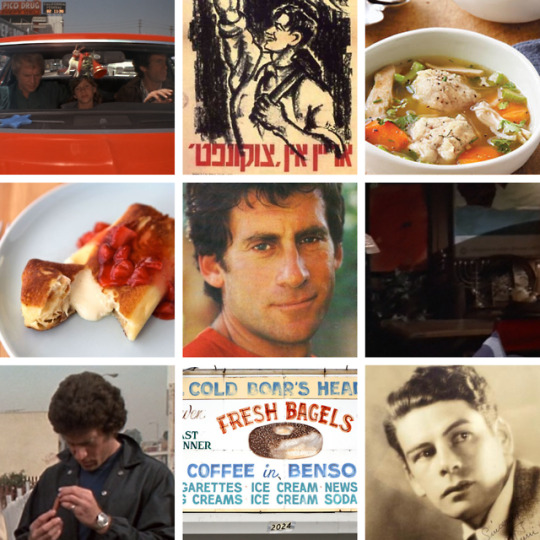
Starsky is Canonically Jewish - A Moodboard & Analysis
A detailed exploration of all the Many Many aspects in the canon that point to Starsky being Jewish can be seen under the cut + bonus headcanons!

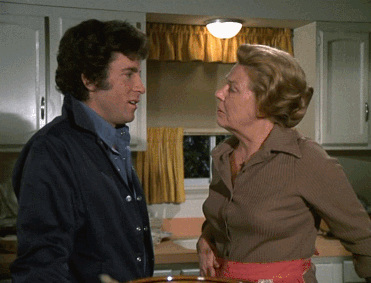
So I was looking at Starsky’s fanlore page and the discussion there talks about hints within the canon that Starsky may be Jewish. As one commentator notes, “There is plenty of mild justification for Starsky being Jewish”. Tbh, I’d say that, whilst subtle and never explicitly addressed, there is far more than just mild justification to suggest that Starsky is Jewish, and that he is in fact canonically so (and also I found the menorah they were talking about and I felt like I was on Myth-busters, which I’ve never seen but I imagine they mainly investigate fandom hearsay regarding background menorahs and other such suggestions. I’m insanely proud for having found it please appreciate because it took me a Very long time to, although I’ve found in researching this that there was at least one screenshot of it online here from 2011 :D).
TV Tropes has Starsky down for the Ambiguously Jewish trope and whilst I definitely agree that Starsky fits this trope description, I would say that there really is nothing ambiguous about it. There are just so so many aspects that come together. This boy is just canonically Jewish!
(Disclaimer: I’m not Jewish. Although I am very much considering converting and I’ve been studying everything I can about Judaism for well well over a year or so now, as well as attending services through whatever means I’ve been able to, I am by No Means even remotely close to being knowledgeable on the topic. Still, I figured there were some things I’d noticed whilst watching that hadn’t been mentioned that I wanted to bring up, and I also wanted to pull together observations by others into one place because I’m always hyped for canon representation and creating coherent resources. Extensive Research Is My Jam. If I’ve got anything wrong; said something in an uncomfortable way; talked where it wasn’t my place to talk; made assumptions I shouldn’t have; or like, said/done literally anything else that feels even slightly off then Please Please say and I’ll do everything I can to sort it!!)
Reasons why I reckon Starsky is canonically Jewish:
For one, Paul Michael Glaser is Jewish and if William Shatner being Jewish is good enough for my Jewish!Kirk headcanons then it’s sure as heck good enough for my Jewish!Starksy headcanons. Furthermore, according to Wikipedia, both Leonard Goldberg and Aaron Spelling are Jewish, and a good many of the writers have Jewish surnames too, though I can’t find out much about them specifically. Due to their fame, and therefore extended biographies, Wikipedia does specify that writers Michael Mann, and Fred Freiberger are Jewish. Joe Naar, who produced the show, was also Jewish, and used to joke that his style “was born out of being a short Jew with a huge chip on his shoulder.” Rick Edelstein was hugely involved in the writing of the later series and you can really see the influence Judaism has on his work, as is evident in his more recent short story, Bodega. He also ended his short video supporting Obama in '08 with "l'chaim, to life".
Essentially, I think Jewish people were involved in all levels of production within the show - from the writing, to the acting, to the direction, to the production - and this can be seen in the varied means by which it’s suggested that Starsky is Jewish himself. As such, suggestions that may have been seen as accidental otherwise can then take on greater significance, whilst the more explicit examples take on more emotional weight.
Why, then, would it not be more explicitly stated that Starsky is, and was always considered to be, Jewish? I read a really interesting post the other day about how Jewish people in Hollywood often felt unable to include Jewish characters/actors/themes in their work out of fear of seeming too “tribalistic, or insular, or that Hollywood was (as it was in the antisemitic imagination) a ‘Jewish’ front”. Obviously, I can’t comment from a Jewish perspective, but when I was younger I felt similar pressure in regards to including queer characters. As such, I think it’s really exciting to see the very explicit references to Starsky being Jewish, even if they aren’t clearly obvious to a wider audience not actively looking for such references.
Paul Michael Glaser also played Perchik in Fiddler on the Roof (1971) - which I mention not only because it shows Glaser playing other Jewish roles, but also as a recommendation because I Love My Hyped Wee Jewish Communist Revolutionary Boy. Glaser talked about how Starsky was a culmination of other characters he’d played prior to Starsky (DVD extras) and I think this is quite evident in Starsky and Perchik’s respective behaviours. As a nod to this, the middle top picture is (apparently) from a Jewish Labour Bund publication. This is something you can learn more about on its Wikipedia article here, and there’s more interesting things about The Bund here and here as well!
As we all know, Starsky calls Hutch the Blond Blintz (to his Puce Goose) :D Here’s a recipe for blintzes from myjewishlearning.com - they’re like pancakes and it’s an Ashkenazim custom to eat them on Shavuot. Also I love the scene in The Set-Up: part 1 where he first calls Hutch the Blond Blintz and Hutch is like???? and Starsky just says Blintz very definitively and with no further explanation and Hutch is just like,,, u kno what,, I’m just going to roll with this.)
I basically just really love this because it’s an example of Starsky being very openly and explicitly involved in Jewish culture, not just when he says it in The Set-Up, but also in Starsky’s Lady, when playing with the kids, especially as there aren’t a lot of references to things that carry on across multiple episodes.
I also like the way he pulls everyone else into his reference of it very un-apologetically; it feels very in character. There’s a picture of a blintz in the left column of the middle row! (Also, I feel like,,,, there might be some,,,, Freudian Implications to naming your partner after a rolled pancake filled with cream cheese that gets released when eaten?? @jimmyandthegiraffes fite me.)
Whilst Hutch looks at a glow in the dark cross being sold by Huggy in Jojo (written by Mann), Starsky picks up a mezuzah, which are put up at gateposts and door frames in Jewish homes - here’s a video about it :D The picture in the left-most bottom corner is Starsky inspecting this mezuzah. I really like this scene because he goes straight to it and seems to be considering it with very real interest. This is interestingly contrasted with Hutch picking up the cross, which isn’t the only time the show appears to draw a distinction between their respective cultural and religious heritages.
I think that really responds to some of the stuff William Blinn has said about their casting and how thrilled they were to have two actors playing characters from such different backgrounds whilst having such great chemistry, and how that really helps form the magic of the show even (DVD extras). I think their respective choices really help to demonstrate how assumed it was that Starsky Would naturally pick up a mezuzah, in contrast to Hutch’s cross.
The menorah (or actually Chanukkiah if we’re going to be really specific about it) in the background of Starsky’s apartment in Foxy Lady and in Blindfold. For so long I thought this was a myth but!! it’s not!!!! You can see it in the right hand column, middle row :D With the greatest thanks to the canon compendium for pointing out the episodes it appears in and also for like, literally everything else - it’s genuinely just the best fandom resource I’ve seen. I love this because I think, asides from a Magen David (Star of David), I think a menorah is one of the most well known symbols of Judaism and I think it’s really rad that it’s something the crew thought consciously to include, even if it is a largely not shown background detail. Again, it’s subtle but explicit which is why I would argue that Starsky is canonically Jewish.
It’s also worth remembering that even though it’s in an area in his apartment that doesn’t get shot by the cameras except on a few occasions, it Is a part of the apartment that’s Really visible from like, every direction and is right across from the front door. I’ve got another screenshot below from Blindfold that puts it more in context of where it is. I think this is really cool!! It’s obviously something he considers a big enough part of his life to keep on display year round and it’s something instantly recognisable and visible for anyone coming into his house (Foxy Lady came out on March 1st and Blindfold on October 21st, neither of which are around Chanukkah, if you’re going by episode air dates).
Speaking of the Magen David :D As can be seen in the episode Little Girl Lost, Starsky has a couple of blue six pointed stars on his dash under his Christmas decoration, as you can see in the top left hand corner of the mood board. I think this is really cool because Starsky is obviously very hyped for Christmas in this episode, hanging reindeer from his mirror and singing Christmas songs and being really hyped for presents, and this could be used to suggest that Oh No He Can’t Be Jewish He Likes Christmas, but not only does he only engage in secularised aspects of Christmas (in contrast to the nativity scene at Kiko’s house), there’s the very conscious inclusion of these stars. All the scenes in the car are set during Chanukkah, which ran from 16-24th December in 1976, and the stars are blue, which, along with white or silver, is often used for Chanukkah decorations and is traditionally associated with Judaism. Basically this remains in keeping with the subtle yet very conscious inclusion of Jewish symbolism, easily missed by those not thinking to look for it.
Also I know heaps of Jewish people that enjoy the secular aspects of Christmas, particularly if the holiday has meaning for their friends. In Starsky’s case this might be more because he wants to annoy Hutch and he likes bickering or perhaps because he’s upset by Hutch’s increasing cynicism and wants Hutch to feel happier. Or because he wants a new caboose for his train set. Probably that.
In the bottom left hand corner you’ll see a picture of Paul Muni, born Frederich Meshilem Meier Weisenfreund, Meshilem being his Hebrew name. I just like that Hutch suggests Starsky’s mother called him Rudolph Valentino and Starsky corrects him saying she “said I was more of the Paul Muni type”, suggesting the actor she compared him to was actually a notably Jewish one (Paul Muni references can be found in Lady Blue, as written by Mann, and Silence). Again, I think the contrast between Hutch suggesting a gentile actor, and Starsky raising a Jewish one instead is interesting, as well as highlighting Starsky’s mother’s engagement with, and perhaps predisposition towards, Jewish culture.
On it’s own this is perhaps more of a curiosity, maybe too much opportunity for coincidence to really warrant too much attention, but Dobey also chooses a Jewish comparison in The Velvet Jungle when he says, “who do you think you are, Starsky, Milton Berle?” So here we have two instances wherein the comparisons drawn with Starsky are with other Jewish personalities.
In Terror On The Docks (written by Freiberger), Huggy apologises for not bringing an ill Starsky chicken soup, instead bringing mustard green broth which, “where I come from is just as effective”. This might not have much significance in and of itself, except that literally just 2 episodes later, in Shootout, Sammy Grovner makes a joke about chicken soup being Jewish penicillin. In addition, Huggy’s reference to his own culture’s cure-all suggests that chicken soup would have been the culturally appropriate first-choice for Starsky. As such, I’ve included a picture of matzo-ball chicken soup in the top left hand corner.
Also, in The Game, Hutch says in regards to their soup related upbringings that, “we obviously had different mothers” and Starsky says, “yeah, mine was chicken soup, yours was,, clam chowder”, which isn’t really that important except that the show likes to highlight their different cultural upbringings and once again they’re doing so by referencing something that is widely culturally understood to be Jewish, having already explicitly stated it within the show to be so. (I could write a whole dissertation about cultural soup references in Starsky and Hutch, but I’m not going to. Just note that there are a weird amount of them.)
We see in Running that Starsky calls his mother every Friday evening. I think this is really interesting because, if they were both observant orthodox, they wouldn’t be using electricity on Shabbat. I mean, duh, Starsky is Not observantly orthodox but this scene shows that neither is his mother. Any yet, the time they’ve picked to talk each week is on Friday evenings, when many Jewish families come together for Shabbat dinner. As such, I think this shows how Starsky’s Judaism holds a place within his life and his routines, as well as suggesting what tradition he may have been brought up in. I personally headcanon conservative, but Reform works too!
As the fanlore page says, “Starsky looked stunned when Nancy's mother asked him if he were Catholic in 'Terror on the Docks,' to which he replied he was not.” This scene is a really interesting one to watch for this (and, again, was written by Freiberger), and whilst this merely shows that he’s not Catholic, his confusion and bafflement suggests just how surprising this question is to him, and his discomfort is evident as he laughs awkwardly. I think this is an experience many minorities can attest to, and he’s feeling the unease that comes when you’re put under pressure to reveal a part of your identity that may well be not received well.
In terms of the canon, I think the way in which this is played is so in line with the concept that Starsky is Jewish that it really suggests that this was something in clearly in mind in regards to his characterisation, at least by a number of the people working on the show.
In terms of headcanons, I like Starsky’s bewilderment here because it seems like he straight up just thought it was obvious that he was Jewish, and so it offers an in-universe explanation for why he never says “I’m Jewish”, rather than the external explanation regarding the fears surrounding creating explicitly clear Jewish characters in the 1970s.
It is interesting, in universe, that he doesn’t then say, “No, Mrs. Blake, I’m afraid I’m Jewish”, but I think this shows Starsky’s reticence to talk about his background with strangers, despite his comfort proudly talking about blintzes with Hutch and Terry. This is frankly just understandable, given the existence of antisemitism and Mrs Blake’s evangelical Catholicism, and again offers another explanation for why he never says I’m Jewish, wherein everyone he feels comfortable knowing already know, so there’s no need for him to say that.
(This said, @jimmyandthegiraffes and I headcanon that he just explains everything he doesn’t know with the fact he’s Jewish, even when it’s totally unrelated, *queue Starsky’s sage voice* “Ah see, I wouldn’t know whether those out of date eggs are safe to eat because I’m Jewish.” - Hutch is going to throw something. Also saying he can’t eat something healthy Hutch has made because it’s not kosher, whilst eating something obviously treif, which I made a post about here.)
We also see Starsky’s reticence to talk about his background with antagonistic strangers/suspects in The Committee, “Starsky? What is it, Polish?” “Something like that.” And yet, in Starsky And Hutch Are Guilty we see Starsky talk with Sharon, with whom he obviously feels comfortable with, about his home cooked goulash, “My mother gave me a recipe straight from the old country.” Again, this shows an in universe explanation for why we never see Starsky talk about his background explicitly, as those who he feels comfortable knowing already know.
This line is also interesting as it suggests information about Starsky’s heritage that pretty clearly implies a family with an immigrant background; this again would be in line with the experience of many Jewish people in the US, particularly when considering Starsky’s roots in New York as many families settled there fleeing pogroms and persecution. I headcanon that Starsky’s father was killed just after his 13th birthday (and his Bar Mitzvah) and moved to Bay City the summer after (this is taking Glaser’s birthday as Starsky’s for consistency).
This would mean Starsky lived in New York 1943-1956. The Jewish population of New York was at its peak in 1950 at 2 million. Still today, New York City is the largest community of Jews in the world within a city proper, including Tel Aviv. I think it perhaps goes without saying that this was and is particularly true in Brooklyn. I’ve seen lots of fics argue about where about in New York Starsky is from (with one claiming New Jersey which was pretty left field). The closest connection to New York that I have is that I grew up on the outskirts of the city it was named after. If you ever want to visit York, it has a lot of chocolate museums and a nice Gothic cathedral and a bad connection with Jewish history. I’m on a tangent. My point is, although I can figure Yorkshire accents, I’m not especially good at figuring out the nuances of New York accents so I leave it up to you lot, and on the whole people tend to suggest that he has a Brooklyn accent. We also know he has swum at Coney Island, and that the sea there tastes better than on the playboy island (Murder on Voodoo Island: part 2).
What we do know is that Starsky grew up on 84th Street (Targets Without A Badge: part 2) although there do seem to be a Lot of 84th streets in New York. We also know that if we are agreeing on Brooklyn then 84th street runs through Bay Ridge, Dyker Heights, and Bensonhurt. I figure Bensonhurst works best because, even though it’s a very Italian neighbourhood now, until the 50s it was a Jewish/Italian neighbourhood, which works with Starsky’s grandmother’s flat above the Italian restaurant (Shootout). It also works with the implications surrounding Starsky’s family and the mob (The Set-Up: part 1) as the Bath Avenue Crew operated in Bensonhurst. The mob thing is also interesting when considering Starsky’s Jewish heritage. There’s a painted Bensonhurst shop front in the bottom middle of the mood board which has been kept the same since the 1950s when Starsky could have been living there!
This has all been largely (or wholly) tangential, but essentially my point is that what we know of Starsky’s heritage chimes pretty neatly with the experience of many Jewish Americans, which again ties in with the argument that Starsky’s Judaism was something held in mind by those involved in the creation of the show.
Another thing I found interesting was in an article I was reading about Paul Simon, born less than two years before Glaser. In regard to Simon, Donald Fagen says, “There’s a certain kind of New York Jew, [...] almost a stereotype, really, to whom music and baseball are very important. I think it has to do with the parents. The parents are either immigrants or first-generation Americans who felt like outsiders, and assimilation was the key thought — they gravitated to black music and baseball looking for an alternative culture.” Simon responded to say that this wasn't too far from the truth. Obviously, Starsky enjoying baseball does not at all mean anything about him being Jewish, but it does fit in with his Jewish New York upbringing, from his father taking him to see the Yankees and him collecting baseball cards (Vendetta), to his enthusiasm with Pete (Little Girl Lost).
It is worth noting how this enthusiasm for baseball seems to be something that Starsky engages in far more than Hutch, which is interesting given Soul's history with the sport. (I feel like they definitely could have done more with the fact that David Soul was a good enough player to be offered a contract with the Chicago White Sox). Perhaps this wasn't pursued because a passion for baseball was thought to be more in line with Starsky's upbringing, versus Hutch's Sea Scouts. Again, this maybe suggests a certain narrative held in mind regarding Starsky’s background and how it influenced his characterisation.
Curiously, any Yiddish on the show is typically said by Hutch rather than by Starsky. In Vendetta, Hutch says to Artie Sorkin, “Fagin, faigeleh. What’s the differences? You’re vermin.” Faigeleh meaning homosexual. Also, as the canon compendium notes, “Hutch calls his houseplant ‘Meschugah Mantherlus.’” ‘Meschugah’ means crazy in Yiddish. “‘Mantherlus’ doesn’t translate as anything but is probably an inside joke and supposed to sound Latin.” (Ballad for a Blue Lady, co-written by Glaser.)
Largely I just found this interesting, but I did read a really cool study talking about the use of Yiddish in the American vernacular and one of its many findings was that gentiles with close Jewish friends were, unsurprisingly, more likely to use more Yiddish terminology. Also, unrelated but super fascinating, LGBT+ people were more likely to use Yiddish too.
On the Jewish immigrant experience, in Partners Starsky tries to get Hutch to play Pinochle with him, claiming "you love Pinochle", suggesting this is a game they frequently play together. Pinochle used to be a favourite card game of Jewish and Irish immigrants. I get that at this point I'm probably clasping at straws but I'm going for as comprehensive as possible, and I think it creates a good story about Starsky playing it with his family and later teaching it to Hutch.
It is interesting how Hutch is possibly shown to be engaging with Jewish culture in regard to both his use of Yiddish and his love of Pinochle. This may well be because Jewish culture permeates American society, after all it's Soul we see say the Yiddish "putz" in the bloopers. But it is slightly interesting that these were lines given to Hutch, perhaps for plot purposes, or because the writers were choosing to include their own culture and ways of speaking in a way that is safer through the evidently gentile Soul rather than the conspicuously Jewish Glaser.
There are other instances of Judaism in Starsky and Hutch that aren’t necessarily pointing to Starsky being Jewish but that are notable. Huggy Bear and the Turkey starts with Starsky and Hutch undercover in Caplan Laundry, where Hutch seems to be undercover as an orthodox Jewish man (and Starsky his wife? Seemingly? They certainly uh, go for it in the bloopers).
Caplan/Kaplan is a surname found in a number of cultures but it is a common Ashkenazim surname which also makes me headcanon Officer Minnie Kaplan as Jewish because we all want more Jewish headcanons in our lives and I think it puts her friendship with Starsky in an interesting context. (Marki Bey more like Marki Bae)
Again, it's Hutch we see taking on the more visibly Jewish role, although this does not go to negate Starsky's own Jewishness, as this may well be understood to be his influence on the friend he spends significantly more than 75% of his time with. Also, it can be assumed that Starsky is undercover as a Jewish woman as he appears to work at the launderette.
Obviously A Body Worth Guarding is the episode that deals most with Judaism as the Jewish protesters are a central plot feature. It’s interesting that Starsky’s involvement with them is largely hostile, however, I think this is more to do with the circumstances. At first he believes they’ve hired muscle to hurt Anna so he goes in hard which means the Jewish Organisation for Action respond with a more hostile approach. And yet, he’s completely on-board with dropping the JOA lead and following the fascist one as a result of Kauffman’s logic that attacking Anna would only lead to more antisemitism, which despite being a sound argument had no actual evidence to support it. From this point Kauffman is still resistant to working with Starsky which means Starsky maybe is more heavy handed in his approach, but it is on order to get Kauffman to help him follow the fascist lead. Once the job has been done he seems a lot softer towards the JOA and genuinely thankful for their help.
Essentially, the episode is noteworthy but Starsky’s reaction to the JOA tells us not so much about his own personal beliefs and upbringing and more about how he approaches his job. I do think it interesting that he believes Kauffman’s logic and subsequently drops all suspicion of the JOA and instead trusts him enough to bring him in as help.
Also Huggy calls the JOA the “desert people” which might just be Huggy’s turn of phrase but I think it feels more comfortable if Starsky is Jewish as it’s more like banter between friends then.
In spite of all these very purposeful allusions and references to Starsky’s Judaism, in Savage Sunday he complains about having to work on a Sunday, the Christian sabbath instead of Judaism’s Shabbat. And yet, I don’t believe this undermines Starsky’s Jewish presentation as it seems that his complaints are more that he expects to have Sunday off because he is in a Christian society which usually allows him a break on a Sunday to which he can look forward to. When he’s complaining about working on a Saturday in Jojo (written by Mann), Hutch says, “Could be worse, could be Sunday”, to which Starsky replies, “Come on, Saturday’s bad enough”, bemoaning all the sports that he could be watching instead.
This is interesting too as you could easily use this to headcanon him using sport as an excuse to express his frustrations at having to work on Shabbat, especially as it’s Hutch who says, “Could be worse, could be Sunday.”
Note: It was mentioned on the fanlore page that Huggy gives Starsky a wreath of garlic ‘for those of other persuasions’, but, as far as I can tell, the garlic is to ward off vampires of “all the rest of the denominations” when the cross for “any vampire of Christian persuasion” won’t be of help, rather than the garlic being for non-Christian vampire hunters. As always, I’m loving Huggy’s enterprising approach to religion, making sure he covers all bases, but it’s not really a suggestion that Starsky is Jewish, just that he needs to protect himself from non-Christian vampires.
In the same vein, Huggy does say “Shalom” to Starksy (and to Hutch) in Dandruff, though this seems to be more as an aspect of his undercover role as Prince Nairobi.
Essentially, Starsky is frequently presented as engaging with Jewish culture, practices, and traditions, often very visibly so. Aside from the very explicitly Jewish references, Starsky is very frequently characterised in a way that suggests his being Jewish was held in mind, on a writing level, an acting level, a direction level, and a production level. As I mentioned earlier, American society in imbued with Jewish culture and so many of these things may have been purely incidental. However, coupled with the more explicit examples of Starsky's Judaism they may be said to take on greater purpose and subsequent significance. Pretty much across the board, he is understood to be Jewish and whilst these references maybe subtle enough to pass by those not engaged with Judaism or considering it a possibility, this does not preclude Starsky’s Judaism from being a very knowing and explicit inclusion, and therefore canon.
Given all this, I have some headcanons about to what extent Starsky is practising!
We canonically know he doesn’t keep kosher – I mean this boy eats linguine with clams. I have read a fic where Hutch is forbidden from telling Starsky’s ma that he eats bacon or meat with dairy and I really like this as a headcanon. I definitely think she Knows but she lets Starsky pretend he doesn’t because it keeps him happy.
We also know neither he nor his mother have qualms about not being shomer Shabbos, but as I mentioned earlier, we Do see them using Friday evenings as the time they choose to call one another.
We know he doesn’t wear a kippah on the regular, too. And he never says the Sh’ma out loud if he thinks he’s about to die, although I do think he probably says it to himself. Again, I think I’ve read a fic about that. As I reread the ones I have bookmarked I’ll add them in if I can find them.
Other than these examples, pretty much everything else as far as I can tell is fair game, particularly if you’re considering along the lines of Reform, or even conservative, depending on the community. I know a lot of Jewish people who would consider themselves to be actively practicing who don’t keep kosher or who work on a Saturday etc.
About that, as I mentioned above, we know he does sometimes work on a Saturday (and he complains about it). This suggests that he doesn’t necessarily frequent synagogue regularly, particularly as he was frustrated about missing the sport he likes to watch on a Saturday.
However, for one thing, this doesn’t mean he Never goes to temple, and for another, we do know that Starsky very likely celebrates Chanukkah, due to his Chanukkiah. Chanukkah is a relatively minor Jewish holiday and so if he celebrates this it’s likely he also celebrates other, more significant holidays, and high holy days. Maybe he doesn’t go to shul every week, but a synagogue on Yom Kippur is generally full of people who are not regular attenders.
Please imagine this boy trying to fast I bet Hutch would be glad as hell that Starsky isn’t at work lol.
Personally, I tend to headcanon that Starsky moves to greater observance post Sweet Revenge. I think the hospital rabbi is good at playing Pinochle and the two become friends and they have good philosophical debates and Hutch joins in and after Starsky is discharged they want to see the rabbi so they start regularly attending shul and they both find something they can get out of it, especially as I headcanon that they retire from the force I think it gives them a community. For Starsky, I think it gives him a connection to his heritage and his family and maybe his father in particular, as well as a focus on social justice work through the synagogue so that he and Hutch can still feel like they’re making a difference. Tbh, I think that Hutch might find a lot to connect to in Judaism, maybe in the way it’s focused on making a difference in the here and now and not in order to access some afterlife. To be clear, I don’t think that’s necessarily the angle Christianity takes but I think it is how Hutch might perceive it and I think he might find Judaism more grounding in that respect. Also, if he converts then Starsky’s ma would be thrilled that if he hasn’t found a nice Jewish girl then at least he’s found a nice Jewish boy and Starsky will tease that Hutch’s hair is so long he might as well be a girl. I think it would create a really interesting relationship between Starsky’s ma and Hutch where they talk about Judaism and she introduces him to recipes and books and stuff and later Hutch is showing Starsky and he’s like, how come Ma never showed me?! And Hutch is like, she tried to idiot you just got distracted. And they can just, explore stuff together. It’s really soft.
Also, I think they host Shabbat dinners every Friday and it’s really cool because it’s a way that they can stay in touch with the Dobeys after they’ve left the force, and how they can stay close with Huggy when they’re not visiting for tips every other day. Also Kiko and Pete can come and then stay the night and spend Saturday with them maybe to give Mrs. Ramos a break. Minnie can come too and say the prayers!! Plus Paco Ortega and Joey and tbh any number of the other kids they’ve accidentally adopted over the years.
Pesach at theirs is just, the fullest house you can possibly imagine I love it. @jimmyandthegiraffes came up with the idea that there isn’t space for Dobey and the boys are like, oh you’re sat on the counter and he’s like? But there’s an empty chair and place set out here?? And he goes to sit down and everyone is like, nOOoO that’s for Elijah!! You cAnt sIT in Elijah’S plaCe?!
Gosh I love them
Starsky high key calls the new year “secular Rosh Hashanah”
Even though I personally headcanon a greater observance after sweet revenge, there really is nothing at all to say he isn’t at least somewhat practising over the course of the series and even that he is, given the Chanukkiah and what that means about holidays. I like how he keeps it up year round to maybe keep in mind his faith/upbringing/background.
I think it’s interesting that many of the fics that engage with Starsky as Jewish often suggest that he’s not religious, which is of course completely possible. However, just because he doesn’t ever talk about a faith in God doesn’t mean it isn’t present, especially when faith is often something so private and proselytising isn’t a part of Judaism. Personally I think that Starsky does have faith in God throughout the series and after, and this does impact his relationship with Judaism prior to Sweet Revenge as he considers things like the mezuzah and engages with Jewish culture, but that it’s after Sweet Revenge that he starts engaging with his faith more as connected to Judaism and religious traditions, rather than I’m going to celebrate my culture and upbringing and also I have a faith in God. He sees the two as more connected perhaps? and his faith as having a more direct impact on his life.
I really like how Huggy says the thing about the chicken soup too, and the “desert people” line is made a lot sweeter by thinking of him as a cool supportive friend who Starsky has known for a long time and who typically engages with Judaism specifically because it means something to Starsky.
I seemingly have a lot of thoughts on this.
Also, I really like how he calls him blintz, weird Freudian implications aside, especially because blintzes can be eaten at any time but are typically associated with Shavuot and I like the idea that Starsky has really a really fond association with his religion but also with Hutch. I really like the idea that if Hutch converts then the two can stay up all night together, eating blintzes and cheese and Hutch can maybe read aloud for my dyslexic boy.
Essentially, I just really love thinking about this and I think there’s more space for an actively practising Starsky than there’s generally understood to be, religious or not, even over the course of the show. Especially if you consider Reform Judaism. But tbh just give me Jewish!Starsky fics and I’m happy whatever they’re like.
I’ve worked really hard to find each scene I’ve mentioned on my DVDs (this post has taken me literally So Long to write (9 months-ish? it’s my Child) and I’ve researched it far Far more than I do my uni assignments whoops), so you can be sure I’ve checked to make sure each reference is legitimate. If you want to see screenshots of these quotations, or you want to know whereabouts in the episodes they occur, then message me! If you have additional examples or you disagree with me or if you’ve spotted a mistake then share that too!
With all my thanks to my partner Chester who’s put up with me banging on about this and spending Hours and Hours being ridiculously pedantic in the hopes of creating as coherent a resource as I can. They’ve also contributed so much and just they’re rad. I also cannot thank enough the canon compendium for helping me fill in all the blanks and pointing me in all the directions I needed to go in, I Genuinely cannot think of a better fandom resource. Also the first 3 seasons scripts are available here which is a huge help.
tldr; Starsky is irrefutably, canonically Jewish and also I love him
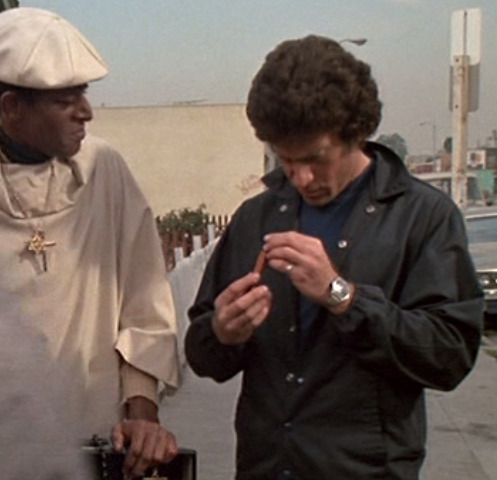
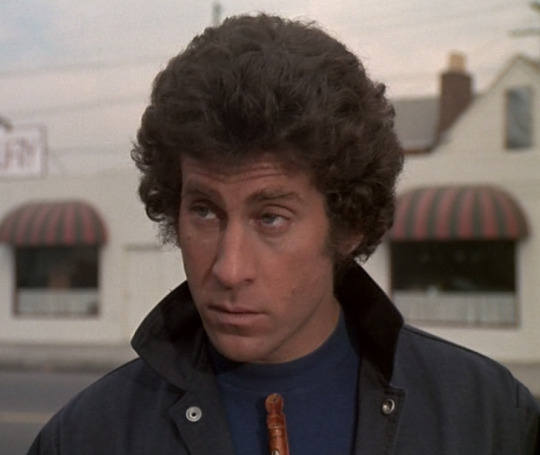

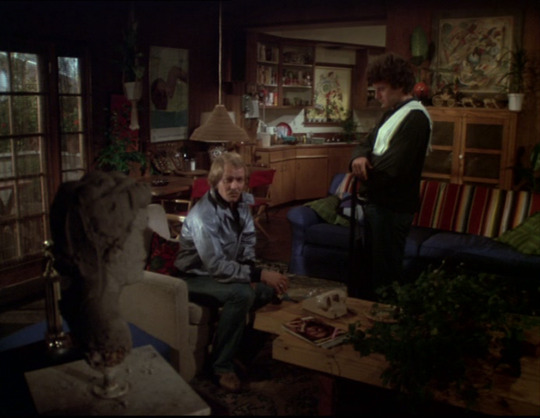
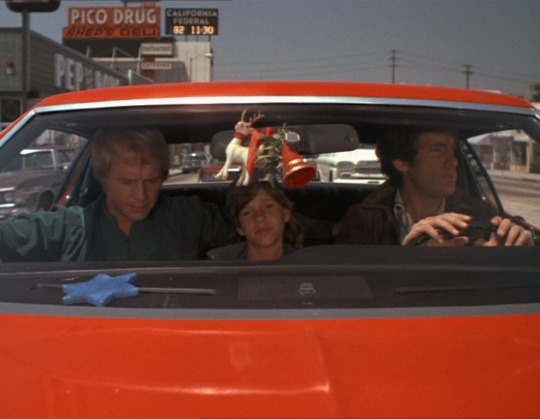
#starsky and hutch#starsky#david starsky#dave starsky#a jewish boy#this took like#9 months#starsky is jewish#this is over 6000 words whoops#my posts
91 notes
·
View notes
Link
Here is the acceptance speech by Travis Corcoran for 2019 Prometheus Award for Best Novel for Causes of Separation. (Corcoran could not attend the Dublin Worldcon but wrote this acceptance speech to be read there at the ceremony.)
I would like to thank the LFS for this year’s award, but more generally, I’d like to thank them for existence of the Prometheus award, all forty years of it. It’s good that our subculture has a long-lived award to recognize excellent science fiction, especially pro-liberty science fiction.
But the Prometheus award is not merely recognition, it’s an incentive!
In fact, I might not have written my novels without the Prometheus to aim for. But the Prometheus is not a financial incentive. The one-ounce gold coin on the plaque is nice, but neither I nor any of the other winners over 40 years would ever trade or sell it, and thus – ironically – it has no financial value.
And yet the award – a recognition by a community – is a huge incentive. There’s an interesting argument here about anti-libertarian tropes like the not-so-veiled anti-semitic and anti-capitalist propaganda of socialist Star Trek’s Ferengi, the bourgeois virtues, and the non-market human flourishing that only human liberty unleashes, but that’s a rant for some other day. Thomas Aquinas said “Homo unius libri timeo” – “beware the man of one book.” The meaning has shifted – almost reversed – from “beware the man who has studied one topic intensely” to “beware the man who has only one simple view of a thing.” I concur with this advice (in both forms!). Libertarianism is absolutely correct in its magisteria (the morality of freedom vs coercion), but we need other theories to augment it when we move our sights from individual liberty and financial incentives to other topics, like culture formation – and culture subversion.
…
Every ideology and subculture likes to tell stories about how it will naturally and obviously win. Nineteenth century Protestant missionaries knew that European Protestantism was the way of the future. 20th century Marxists knew that Marxism was. In the early 21st century Wired magazine told us that “netizens” would use technology to create a brave new world. The fact that every one of them has been wrong so far should inform our Bayesian priors. Perhaps cryptography, bitcoin, and the internet aren’t going to create a libertarian future. Perhaps the future looks a lot more like Orwell’s boot stomping on a face, forever.
Why might this be, and – if it does – how might we respond to it?
Last year I spoke about the essay “Geeks, MOPs, and sociopaths in subculture evolution” by David Chapman, which argues that new subcultures are pioneered by geeks, appreciated by members of the public, and taken over by sociopaths. His thesis is a particular example of a more general case.
There’s also Pournelle’s – yes, that Pournelle – iron law of bureaucracy” which states “In any bureaucracy, the people devoted to the benefit of the bureaucracy itself always get in control and those dedicated to the goals the bureaucracy is supposed to accomplish have less and less influence, and sometimes are eliminated entirely.”
Robert Conquest’s third law expresses something similar: “Any organization not explicitly right-wing sooner or later becomes left-wing.”
Chapman’s essay and Pournelle’s and Conquest’s laws are three observations of a single underlying phenomena: the collectivists always worm their way in and take over. We know THAT this happens, but WHY does it happen? How can we model it and understand it?
…
My theory, which unites Chapman’s “Geeks, MOPs, and sociopaths”, Pournelle’s Iron Law, and Conquest’s Third Law is this: organisms, whether they’re unicellular, multicellular, or purely information, like Dawkin’s memes, egregores, and ideologies, mutate, evolve, and are selected for. Those that are best at surviving and reproducing soon dominate the population…and one of the best ways to survive is secure energy resources by hunting, killing, and eating (or, more gently, parasitizing) organisms that do the hard work of harvesting energy and building structures.
David Hines has a great essay at the status451.com blog titled “Days of Rage” where he discusses the surge in left-wing organizing and terrorism in the US in the 1970s. One thing that Hines points out again and again is that collectivists plan, they train, and they invade. I note that their organizations also exchange members and ideas (mate) and fission (reproduce). We are looking not just at a parasite, but at a class of parasite, forged and refined in the Darwinian furnace.
Evolution is a harsh mistress.
…
Predation and parasitism are selected for in the biosphere because they are efficient. They’re selected for in the realm of human culture for the same reason. It’s easier to harvest energy from a parasitized host species than it is to grow leaves, and it’s easier to take over a subculture than it is to create one. Thus science fiction will always suffer wave after wave of entryists, trying to claim the subculture for themselves. And, like Orwell’s Big Brother, they will rewrite history to declare that they invented it. “Let me join your club. You have to change now that I’m here. You have to leave now. We all agree that I made this, decades ago.” We see that all entrusts do this (“The United States was always about social justice ; the Jewish faith was always about social justice ; this TV station and car line and toothpaste were always about social justice”) and we conclude that they do because it is the optimal strategy, tested and chosen by evolution.
So, is that it? Are we doomed to lose all battles, to be preyed upon and parasitized?
In the biosphere, only a minority of organisms are predators or parasites. How could it be otherwise? Someone still needs to do the hard work of capturing solar energy and building biological matter. So too in the world of human culture. Tax-thieving governments and culture-thieving brigands can’t kill the goose that lays the golden egg. The Lotka-Volterra equations, first developed in 1910 to describe chemical reactions, but echoing Pierre-François Verhulst’s logistic equation from almost a century earlier quantified the mechanism.
And, since biology is economics is sociology, I note that Mancur Lloyd Olson Jr.’s theory of roving bandits, which are willing to loot everything from a village, and stationary bandits, who learn to restrain themselves so as to keep the village alive, and capable of being pillaged (or “taxed”) again reaches the same conclusion: predators can never outpopulate the prey … at least not for long.
Based on Lotka, Volterra, and Olson, then, I suggest that the collectivists’ social entryism will never be total. Negative feedback loops will ensure that. When will the entryist wave peak? Perhaps it already has. The last decade saw the cultures of video games and comics under attack from entryists, but perhaps the high water mark has already been reached, as we’ve seen several horrific market failure, such as the female Ghostbusters fiasco, Mass Effect: Andromeda, or that time when Zoe Quinn of comicsgate / Five Guys fame was given a DC Comics title. As the Twitter meme says “get woke, go broke”.
But on the other hand, perhaps not. Strauss–Howe generations theory, which I tentatively give the nod to, suggests that we’re going to be deep in the suck for quite a while yet.
…
What strategies can we use to improve our odds, to make life somewhat more tolerable in a world where Darwinianism means that threats are ever present?
Look to biology.
We can evolve physical defenses, we can evolve camouflage, or we can adapt to new environments that are less conducive to predators.
What do these mean in social terms?
Physical defenses means organizations building mechanisms to keep entryists out – a topic on which I am not an expert…and Pournelle’s Law and Conquest’s Third Law suggest that perhaps no one is.
The social equivalent of camouflage is a mixture of esotericism (in dangerous times people speak in code) and foot-dragging Vichy coexistence. Scott Aaronson and Slate Star Codex wrote essays on “Kolmogorov complicity” (a good pun on Kolmogorov complexity), and I urge you to read them.
My favorite, is the third option: moving to where the predators aren’t. Which – surprise – boils down to my old favorite, exit.
Jame C Scott talks about exit extensively in his book “The Art of Not Being Governed: An Anarchist History of Upland Southeast Asia” and in his later book “Against the Grain: A Deep History of the Earliest States”. He makes the core point that when you see a populace that does not have certain social technologies, that does not mean – contra the default narrative – that they never evolved them. Sometimes populations intentionally abandon technologies because those techniques make them legibile to control and subversion by the overculture. If you want to avoid computer viruses, rip the computers out of your Battlestar. If you want to avoid land taxes, burn down the land registry, or become nomadic. If you want to avoid having your subculture taken over by collectivists … what, exactly?
3 notes
·
View notes
Text
Borderlands 3 Review
*Writer’s Note: I played this game when it came out and have based my review on the version of the game that I played then. Some of this information may become outdated with time.
DISCLAIMER: This review is going to contain a lot of spoilers for Borderlands 3, if you don’t want that then this is not the review for you. My overall opinion of this game is that it’s… okay. It entirely depends on what you value out of a video game. Borderlands 3 is, at heart, just another Borderlands that’s been somewhat dumbed down, and if you don’t like the Borderlands series’ base mechanics (i.e. farming, constantly throwing away weak gear, getting stomped on for being underleveled) then this is not the game for you. If you value storytelling in your video games, this game is absolutely not the game for you. However if you’re someone who just wants to shoot some guys and already like, or think you’ll like, Borderlands’ looting systems then this game is going to range anywhere from okay to good. It should be kept in mind that this review is meant to take into account many of the different aspects of the game, hence why this review is going to have a far lower score than many other reviewers/media publications seem to be rewarding it.
I don’t really know if Borderlands 3 is worth the $60 asking price, and I would ultimately say to either wait for the game to go on sale or at least wait for it to go up on Steam. This is because the game really is just a dumbed down Borderlands entry, you could easily just go buy the Handsome Collection for $60 (if you haven’t already) and have just as good, even better, of a time. Also that Steam has more laid back refund policies than the Epic Store (which can be blamed for this review existing in the first place). But this is where the spoiler free section ends, anything past this point will contain heavy spoilers for the sake of in depth discussion. You have been warned.
When the Borderlands 3 reveal trailer came out back in March I was entirely skeptical that the game would be anything good. The story looked like a mess, the guns looked like complete shit, and overall it appeared that a lot of the things they were promising on were too good to be true or would end up simplified. Also, at the time I had just played through the entirety of the existing Borderlands series (excluding Tales From the Borderlands), so this new game was going to have to spike a certain chord with me. This definitely wasn’t helped by the “additions” that they tried to make to those games such as second game’s graphics enhancements, and the Borderlands 1 remaster. The former, while making the game look prettier, had the problem of cutting off cross platform play (across PC, Mac, Linux, etc.) which left a small crowd of people very disappointed. And the latter had the issue of being a complete load of garbage with many of the same bugs, new performance issues, clunkier menus, new menus not working, and of course Gearbox’s patented golden chest. They pulled a BL2 and just gave you OP guns at the beginning of the game as to make the beginning area more trivial than it already was. And if that wasn’t bad enough, they suited you out with 75 golden keys for connecting your shift account, meaning that you could destroy any sense of value the guns originally had.
There was also the new BL2 dlc that was meant to tie the game into BL3’s story. However I can safely say that after having played through BL3, this dlc’s campaign in no way whatsoever connects these two games together. I guess at best it explains how Sanctuary fell, but that in of itself has a lot of problems. You get attacked by some Dahl commander (who has never been brought up in the story before) where he infects Sanctuary, and by further extension Pandora, with this plant virus. Your job is to kill this guy and stop the plant virus. There is no motivation established for this guy besides that he wants to make Pandora into some paradise, and the story has absolutely no effect on BL3 at all. The crew was already set on going to outer space, this invasion only served to speed up this process. To further this claim, there is no mention of this dlc’s events in BL3 and Pandora is still the same sandy hell scape that it normally is.
Which finally brings us to Borderlands 3. A game that feels surprisingly devoid of passion and love despite how much effort went into it. A game that feels like there wasn’t enough time to flesh out ideas. A game owned by a company who sold out to Epic for money- let’s get a couple of things out of the way first. 1. Borderlands 3 isn’t an entirely bad game per se. 2. I have relatively no issue with the game being an Epic exclusive and my opinion is not biased or soured due to Randy Pitchford’s constant fuck ups.
However, that doesn’t mean that I don’t outright despise Gearbox and 2K for their actions. They take an exclusivity deal with Epic which actively disrupts consumer convenience and confidence in purchasing their product (not a big deal). But then they have the audacity to push this game out in the buggy, unpolished, and unoptimized state that its currently in (kind of a big deal). The menus are buggy on a basic, functional level, the performance tanks constantly, and items would quite literally disappear out of thin air from my inventory. All of these made Borderlands 3 just that much more of a painstaking experience to play through.
It was the unpolished game and the Borderlands’ trademark shitty introductory area that made me want to refund the game. And believe me, I tried to refund the game. Unfortunately I got denied my refund because I had accidentally played over 2 hours of the game, when the Epic client doesn’t even show your playtime. So ultimately I had no choice but to play this game in order to get my 60 dollars worth. In that time I learned that this game is exactly like the other Borderlands games. Right down to the pacing and the disappointing endings. The beginning of Borderlands 3 is a complete slog. You’re just slapped down on Pandora and have to suffer through Clap Trap’s “hilarious” writing and get formally introduced to the mechanics of a Borderlands game for the 4th time now. Gearbox has apparently never figured out that people really hate playing through the beginning of their games because it refuses to give the players a skip tutorial option or a way to just outright bypass the introduction. Now I will say that this introduction isn’t as bad as BL2 or The Presequel, but it's certainly nowhere near good either.
The problem with these introduction areas is that they aren’t engaging or really even play into the story in any meaningful way. In BL3, you arrive out of thin air on Pandora and are forcefully met up with Lilith and the Crimson Raiders so that you can prepare to take off into space. Between meeting up and going into space you’ll be doing menial tasks such as fixing Marcus’ shops, getting a basic vehicle, and doing some really boring boss fights. Your motive for killing these bosses is because Lilith is on the hunt for the vault map. That thing that they had in BL2, how did they lose it? Nevermind that because it’s just sitting with Mouthpiece, a painfully easy boss that expects no brain power out of you other than just avoid the giant speakers that go boom. Apparently it was in Vaughn’s possession before he was betrayed by his Sun Smasher clan in return for good boy points from the Calypsos. Why the Crimson Raiders thought it would be a good idea to leave the map with Vaughn beats me, but I can safely say that this theme of Vaughn being a complete fuck up is consistent throughout the entirety of BL3.
Vaughn at best feels like a comedic relief character, and at worst feels like padding. This character has no important role throughout the story, just plainly isn’t a funny character, and comes across as a complete waste of space. He could literally just disappear from the entire game and nothing would change. You (luckily) don’t even see him for most of the game because his ass is left back on Pandora to do… something. I’ve heard that Vaughn is a far better character in Tales from the Borderlands, however as I haven’t played that game I cannot say for certain whether or not Gearbox really just dropped the ball on this one. Vaughn also isn’t the only character I have this opinion of, however as I am still discussing the game’s intro I feel that I should hold off until later.
So after you acquire the vault map and experience a “high stakes” encounter with the Calysos, Lilith loses her siren powers. I feel like this was supposed to be some big, “Oh shit,” moment but I have to express that I simply don’t care for Lilith’s character and people who are new to the Borderlands series won’t care either. Lilith is not necessarily a “good guy” in Borderlands. She has done some fucked up things that have drastically changed the overarching plotline and a lot of people’s perception of her both in the story and by players experiencing it. In The Pre-Sequel, she is framed as being the reason for Handsome Jack’s insanity as Lilith literally branded a vault symbol onto his face. In the epilogue of TPS she actively commands a firing squad to gun down Athena after she tells her story in its entirety, completely against the judgement of her colleagues. And she makes incredibly rash decisions in BL2 that causes detrimental results for the crimson raiders such as being captured by Handsome Jack after being explicitly told not to come to Angel’s prison that greatly changes the dynamic of the story. These are only a couple examples, and I could keep going, but the point is that I don’t value Lilith as an entirely productive or a beneficially proactive member of the Crimson Raiders. And new players who have never played Borderlands before literally won’t even know who Lilith is or why she is even important. Hence when Lilith loses her siren powers after a pretty pathetic fight with the Calypsos, I can really only roll my eyes and just go with it.
From here the story relatively picks up and becomes a bit more bearable (but not really), however I don’t want a couple thousand words of this review to be about the story. Overall it’s trash, and I’m going to try my best to summarize just why it’s trash. Firstly is that the Borderlands writers might be writing for way too many characters. Seriously you have: ProZ-oh I mean Flak, Amara, Zane, Moze, Vaughn, Lilith, Brick, Mordecai, Tiny Tina, Ellie, Tannis, Marcus, Zero, Rhys, Lorelei, Aurelia, Hammerlock, Typhon Deleon, The Calypsos, Katagawa, Bosses also have some writing with them, Ava, Rhys, holy shit I could just keep going. This isn’t to mention that the the only returning vault hunters from BL2 are Zero and Maya. And then factor in that the writers had to write up a ton of audio logs, some Typhon logs, Eridian logs, side quest dialogue for meaningless bosses, etc. and you have just this disaster of a story that churns everyone out to be really shallow characters. There aren’t any truly good characters in this game. Some of them are passable but that’s because they either aren't main characters or they have some somewhat funny writing and redeeming qualities.
Characters like Ava and Maya (and Vaughn) are completely devoid of any purpose within Borderlands outside of being fuel to the drama fire or just outright being an obnoxious brat. It’s pretty obvious that Ava is just a spoiled teenager who has no idea what she’s getting into, but even in the context of Borderlands her character doesn’t fit at all. For example, after the player kills the first vault monster (Rampager) and returns from the vault, you’re suited to a cutscene where Ava and Maya go pants on head retarded. Ava, a defenseless, tiny, teenager with no powers whatsoever, tries to tell Maya that, “We should be kicking [the Calypsos’] asses!” after the Calypso twins show up to absorb the powers of the vault monster. Mind you, this is after her and Maya debate about how Ava is a piece of shit that’ll get herself killed if she sneaks off to more vaults. Ava then has the audacity to tell the vampire sirens that eventually she’s going to be a siren and she’s going to, “Mop the floor with assholes like you.” These actions ultimately gets her put in her place, and Maya killed. Bottom line: She’s an obnoxious character that makes playing through the story of BL3 worse the more you’re exposed to her. And speaking of Maya, her character in Borderlands is completely useless. She introduces Ava, and then gets killed so that the players can go grrr at the big baddies. Her only significance to the story is that Maya is a siren so that the Calypso twins can steal her powers. Otherwise she is an absolutely useless character that now we’ll never get to see again without Gearbox pussying out on their own writing.
I’ll be completely honest here in saying that Typhon Deleon was the best written character in the game, and you hardly get to hear anything from him outside of backstory and the final couple hours of the game. If Typhon Deleon was a main star of BL3 I think the story would’ve went in a much more favorable direction. However I can’t discount the good writing moments within the story. Even though I absolutely hate Flak’s character even down to his voice, he does have some lines that made me chuckle. Rhys’ entire gag about Rhys ball had me laughing for that entire section, especially the line, “Suck on my big ball, Katagawa.” In fact I think most of the jokes that I laughed at were sexual jokes. I frankly don’t think a lot of these sexual jokes make the cut in a lot of games nowadays outside of obvious fanfare or really out there stuff like Grand Theft Auto 5. This was really unexpected and pulled off well in BL3 as weird as a compliment this is.
I also just want to express my disappointment for how the old vault hunters were treated in this writing: Axton, Gaige, Krieg, and Salvadore aren’t present in this game outside of some echo logs. It could be plausible that Axton and Gaige will come back for a future dlc, but I’m not holding my breath. We ultimately got Maya and Zero, and oh god these characters are bad. Maya dies only a couple hours after you meet her and Zero is comparable to a boomer dad trying to be hip with the kids. Maybe that’s the joke, in which case all I can say is, “Wow, they pulled it off really well and I’m not laughing.”
And finally, the Watcher. What the hell happened to this dude and why isn’t he in BL3? He appears at the end of TPS and is like, “You’re gonna need all of the vault hunters you can get,” however, not only do we have a very restricted roster of vault hunters, the Watcher is literally never mentioned again. Unless the Watcher is the Eridian that left all of the audio logs laying around, but what a disappointment.
I could keep going a good while if I wanted to, but that’s reserved for my videos. The next part of the game that should be brought up is the world design. Most of the world design is okay, I wish Pandora wasn’t just set in desert hell ala BL1, but other than that they seem to have enough content and discoverable areas to make them interesting to explore. My ultimate problem with the world building comes in when considering the planetary system in the game. Now this point can be entirely perceived as me just being an ass but when I think “planets” I expect a lot more than the world hubs in BL3. The planet’s levels are relatively small scale for being on, you know, a planet. And this isn’t just a problem with BL3, many other games that have incorporated planets like this, such as Destiny and Warframe, ultimately fail at capturing the scale of planets. A planet is often scaled down to a simple level within a video game, and it’s somewhat shameful to see a game boasting, “tens of planets to travel to” and then those planets have the same (and even less) scale as their previous title entries that were based on a singular world. Now I perfectly understand that this is a hard request to answer to, and having to build and construct one world is difficult on its own. Despite this, if a development/marketing team wants to promote their usage of a planetary system in their video game, it’s implied that the levels are going to be gigantic. It’s not at all impressive to see planets being used in BL3 because BL2 had the same, if not more, level variety and the same, if not more, amount of levels without the pseudo use of large scale.
This isn’t to say that the levels contained in the game are bad, just that I wish they weren’t pushed into a planetary system. Generally speaking, the levels aren’t bad. I hadn’t ever reached a part of the game where I thought, “Wow this level is trash,” or found levels that were broken. In fact, the gameplay and level design seem to be the real highlights of this game. Gameplay this time around has been modernized and sped up. Players are suited with a slide, ledge grabbing, barrel throwing, and melee slams. Sliding in of itself is important because of how non-committal it is as you can cancel a slide instantly by jumping. These additions ultimately make combat faster and more varied in how you approach the game. See Borderlands 1, 2, and TPS (while it tried) suffered from each fight encounter being basically the same shootout with basic cover systems. This time around, while you can still use the basic playstyle from the older games, you’re provided the methods to really make your gameplay interesting. Personally I never used the melee slam or the barrel throwing, and the new ledge grabbing system only serves to add verticality in map exploring from my experience. However I did use a lot of the slide, and given the right gun (especially shotguns) it became very satisfying to slide into an enemy and pop them into the air with a shotgun.
On this note, I feel like I have to express how much I disliked the feel of the guns. And clearly I am on the contrary opinion here because I have heard everyone on the planet say that, “Wow the gunplay is soooo good omg!!!” but I’ll be honest in saying that I didn’t see it here. Sure, the gunplay now feels more weighty and the new animations and stuff are nice to making the player character good gameplay feel. But the guns themselves, despite apparently having tons of funding behind making the guns sound good and being completely reworked, still have the chronic floaty-ness issues of the previous games. Some guns (primarily early game Hyperion SMGs, Maliwan guns, and some shotguns) just felt so awful to play with that I put them down and never touched them again. I’m not too sure what I was expected as I slid into an opponent and shot them in the face with my shotgun, only for them to fly away a couple feet and just get right back up only having lost about half or less of their health. Jakobs guns were consistently the best weapon, feel wise, despite me always wishing they had a bit more of a kick to them.
One of my major issues with the guns is that they are way too sci-fi and not enough like guns on wastelands and battle driven hell hole. Seriously for how terrible a place Pandora is, you don’t get weapons that reflect this attribute, Instead you get these futuristic Hyperion smgs that will project a shield out in front of you or a Torgue gun that will home into your target when thrown. This is a consistent theme throughout the game where guns won’t aesthetically match the environment. I could understand if you found futuristic guns on Promethea, or even that you find technologically advanced weaponry in the form of Hyperion leftovers on Pandora(given that they’re consistent with the styling of BL2). This would 1. Appease me, because I am the only person worth pleasing, and 2. Would allow the Gearbox developers to create more variety with their weapons so that the game actually feels like it’s hitting its promise of, “Billions of guns.”
Another issue I have is the sound design for these guns, which is probably the point I’ll get absolutely grilled for but: Using actual sampled gun sounds apparently does not work for video games. Seriously every time a game tries to improve the sound of its guns, the new sounds somehow turn out to be worse. This can easily be explained off as having a bias against change, but let's talk about it. Firstly, the guns are way too quiet in Borderlands. And they seem extra quiet in BL3, like worse than BL1 quiet. Maybe it’s a difference in subtlety, because let’s face it: It’s not like a microphone was stuck right next to an actual gun. In reality the sound designers probably had the microphone a good many feet away. This gives the gunshot more of a subtle popping sound rather than the huge blast that the person holding the gun actually experiences (hence why you wear earplugs when shooting guns in real life). But I’m going to put in my take on this matter: Guns need to have an impact in their noise. Now this doesn’t mean that guns sounds even need to be based on real guns or realistic in any shape or fashion. Borderlands is a game with a unique artstyle, so why can’t Borderlands have unique sound design?
It seems that every game nowadays wants the best sounding or most realistic guns to boot, however what happened to all that stylistic choice? Some of the best examples I can think of are Counter Strike’s western inspired whiff sounds for its older titles, Enter the Gungeon’s wide arrangement of different gun sounds, the cartoony gun shot effects for Wasted, and even Borderlands unique sound designs such as The Bane and the beam guns from TPS. These unique sound designs are missing for BL3’s guns and, despite Gearbox making an algorithm to suit one gun sound to thousands of guns, they all really sound the same. Not like you can’t tell the difference between what you’re shooting but in that all snipers sound like a generic sniper, all pistols sound like pistols. Of course you have to discount certain weapons like the Occultist that don’t even shoot the bullets respective of its weapon type. But the point is: this is a missed part of the game. I don’t necessarily like or dislike the realistic approach to the sound design of weaponry, but in a game that feels anything but realistic, the sounds aren’t doing it for me here.
But let’s reel it back to the game again, and get into the basic looting mechanics for this game. Upfront: It’s dumbed down, and takes little effort to get good gear. This is the part of the game where I fall out of my element (if I haven’t already), because I don’t really appreciate Borderlands for its RPG mechanics. It feels nice, and the act of finally getting something you grind out for hours if exhilarating (4 times magic missile), but it is far from how I prefer to play my games. Given this though, even I feel that legendaries drop way too often. Over my playthrough of just the main game content (I did 6 side quests on my first playthrough, and we’ll get to this) I collected tens of legendaries. When I was finished with the game I had 10 legendaries just sitting in my inventory that I was either actively using or keeping as a memorial item. This isn’t to mention that you literally get a chest at the end of the game that contain 4 legendaries in it. The loot dropping system is no longer satisfying at this point. And this isn’t just a matter of, “Oh they buffed the loot drops a little bit,” it’s a matter of the looting system becomes a complete joke when bosses can literally drop multiple legendaries without Mayhem, and will consistently drop multiple legendaries with Mayhem.
Assemble this with a forgiving leveling system, and now it’s just a dumbed down Borderlands experience. In previous Borderlands games, you couldn’t just do the main quest from start to finish. At some point you would eventually become underleveled, and paired with Borderlands’ trademark unforgiving and shitty rpg mechanics, meant that being 3 levels beneath an enemy granted you 10% damage reduction. This is no longer a worry, you can now play the main quests from start to finish with zero leveling hiccups. Or at least from my experience. Some reviews that I indulged in have said that they did have troubles with the leveling system, to which I rolled my eyes and had to immediately question what the hell they had done wrong. On normal mode I finished the campaign having only completed 6 side quests in total. One of these, to tie back to the looting system real quick, gave me a legendary elemental pistol that melted enemies for the next couple of zones. I also asked someone about their experience playing Borderlands 3 so far, only to learn that he had been doing every single quest that he was given and was massively overleveled come time for the first vault boss (he was level 21).
The bosses of Borderlands, this time around, were the best and the worst that the series has ever gotten. They’ve been massively revamped from the older system of AOE insta-kill moves to having actual attack patterns that you can skillfully avoid. To compensate for this, the bosses have been relatively tuned up to be more aggressive, throwing out more attacks. These new bosses range from very good to very, very bad. Some of my favorites were the Graveward, the Penn and Teller styled boss (Pain and Terror), and Troy Calypso. The bosses that I ultimately ended up hating were Katagawa, the Rampager, the Warden, and the Anointed. These bosses either suffered from boring attack patterns, bullet spongy-ness, or a lack of direction on what you’re supposed to be doing to beat the boss. Katagawa and the Warden fit into this last category. For Katagawa I was confused by him taking inconsistent damage (he loses a ton of health on shield break) and the Warden I couldn’t figure out whether or not I was allowed to kill him early. This is because the Warden is styled around the Goliath from BL2, so whenever he kills one of his teammates he gains all of his health back and then levels up. It turns out that you can kill this boss early, I just had garbage guns for this fight. So to answer your question, yes I did get the Warden to max level, and what pursued was a 20-something minute boss fight where you run the boss around in circles and turn around to deal damage when you can, and then he would kill a minion and level up. The only way I managed to kill him was that when he did eventually hit max level, he would stop focusing his minions when on low health.
The bosses that were truly good were the ones that kept the player busy, while not being too spongy or time consuming. It should be noted that the spongy factor of a boss can be easily biased by what type of weapons you enter a boss fight with. Some of the bosses I thought were easier may have actually been harder for you or another player, and vice versa. However, I will speak more of a general design philosophy and less of a, “This guy had too much health,” philosophy. I loved the Graveward (while admittedly being underwhelming for a vault monster) because of his unique battle area and clear attacks that would make his weak point exposed. Having the entire floor tilted to the side while you’re spamming jump to save your life was a fun mechanic to work with, especially when you factor in dodgeable acid balls. This was a simple boss fight that had a unique spin on an FPS boss. Terror and Pain I loved for stylistic reasons and the meta-humor around putting characters themed around Penn and Teller in a game made by a company with a CEO who is super into magic. This boss is comparable to Mouthpiece, but actually just a straight upgrade. The arena you fight Terror and Pain in is far more interesting, the boss itself looks cool, and while I have honestly forgotten the attacks that the boss had, it was still a fun encounter. One of the attacks I do remember though is the floor lighting up to indicate that fire was going to shoot up to incinerate you, and felt far more fitting than getting blasted by a speaker turned up too loud.
Something that I disliked across the board with these bosses, and this is a massive opinion piece, is that the bosses were too easy. Sometimes I honestly wished I was playing Borderlands: The Bullet Hell. I really wanted a boss that wasn’t just going to engage my attention, but make me feel like, “Holy shit, holy shit, oh my god, I am going to die.” Actually, the entire game was pretty damn easy. Although this can come down to a lot of reasons such as ally NPCs now being able to revive you, and the upped pacing of the game causing players to need to rely less on cover.
And I mean, it’s not like the game stays easy forever right? After you complete the campaign on normal mode you then unlock True Vault Hunter Mode (TVHM) and the brand new, super cool, “Badass-,” oh whoops I mean, “Guardian Ranks.” The end game is perhaps the most disappointing thing is this game for hardcore veterans of the Borderlands series. Firstly, that “reworked” end game comes in the form of the new badass ranking system, only this time you can’t disable it (This pieceo of information has become outdated with time, a future update has included the option to turn off these gaurdian perks and the passive bonuses). I mean, this time you get some rewards for using the guardian ranks? Meh. Otherwise the game still revolves around making you play it multiple times in order to get to the level cap. The only real reworked thing here is the new mayhem difficulties, annnnd they’re bad. So what the mayhem system is supposed to do is make the game more difficult while incentivizing you to play it by giving you consistently better loot rewards (more blues, purples, and legendaries). This system would otherwise be okay if not for just one problem: Mayhem 2 added no difficulty to the game, while Mayhem 3 felt typical to Borderlands end game difficulty (It should be noted that the Mayhem system has been revamped to include 10 Mayhem levels). Again, this may be because of my own personal experience with the game, see apparently Flak is outright broken when it comes to crits (Future updates have severely nerfed Flak). So this could be influencing my opinion greatly on this difficulty switch. But I’ll say that I had no reason not to play Mayhem 2, because for essentially no difficulty increase, the game started commonly dropping me blues, purples, and legendaries, while rarely spitting out a green.
At this point I had essentially had enough with the game, as my terrible, clunky inventory was constantly filling with valuables, and I had to make constant stops to dump stuff out of my inventory. Given this, the fact that Mayhem gave you a ludicrous amount of XP for very little difficulty on Mayhem 2, and a quick Google search about the raid bosses in the game, I’ve ultimately put the game down. I went from level 39 to 44 in the span of an hour, was being drowned in good loot, and the biggest sting of all: There are no raid bosses in the base game of Borderlands 3.
This is a massive review for a game that probably doesn’t deserve it. Borderlands 3 has a lot of ups and downs. It’s not a game that many people will enjoy for the story. Veteran players may have a distaste for the lack of an interesting end game. All in all, if you’re playing Borderlands 3, you’re probably playing it for the gunplay and the loot, which still, somewhat, hold up. I didn’t see how the game had a billion guns, but you know what, that’s alright. And after all of the controversy, and now that Gearbox is releasing patches, performance fixes, and balancing to the game, it’s not that bad of a game. The game just doesn’t strike me as the godlike triple A, return to Borderlands that many had hoped for. Overall, I would give the game a 6/10.
EDITOR'S NOTE: There used to be a video here demonstrating a supposed XP glitch that had occurred to me while playing through True Vault Hunter Mode while using Mayhem. It turns out that, at the time, this was an intentional mechanic for Mayhem to give you massive XP gains. To correct for this error, the video has been pulled from Youtube and this paragraph has been written, as well as all mentions of the XP glitch being pulled from this article.
-Count_
1 note
·
View note
Text
Empty Spaces
I let Youtube recommend me some videos last night. This is a dangerous thing for me to do, so I tend to avoid it, but it worked out kind of OK this time out. This time out it said "Hey, you should watch a Vsauce video." So I did, and then the sidebar suggested I watch this video by someone called Solar Sands called "Liminal Spaces (Exploring an Altered Reality)".
I've been interested in liminal spaces for a long time. I can't tell you how long, exactly, but I can tell you where I first came across the concept of liminality. It was in Thomas Pynchon's book Gravity's Rainbow.
Gravity's Rainbow is one of those Books About Everything by a Clever Cisgender White Man. I'm not actually smart enough to read it, despite having attempted it several times. (I did read Infinite Jest one summer in the '90s, for whatever that's worth.) As Clever Cisgender White Men go, Pynchon is one of the ones I actually like a lot. Gravity's Rainbow is the Big One, his Trout Mask Replica, the one people go to, but like Trout Mask Replica, it's not actually his best. Pynchon grew and matured as a writer in the decade-plus he spent smoking weed after Gravity's Rainbow. He finished and published his White Whale book, Mason and Dixon, and then came to the realization that Books About Everything were not the be-all and end-all of novels. My impression is that his subsequent books are very much not about everything and are better for it. That said, I haven't read any of them. I could, probably, in that I'm smart enough, but something about Gravity's Rainbow keeps me away from even his other books. Also I don't read many novels.
Anyway. I wound up reading it as though it were a reference book. I'd skip around into various different bits. Usually these turned out to be the dirty bits. Over time the book developed a will of its own, as reference books do, and just started taking me directly to the dirty bits.
Which of course means I read the bit about liminal spaces a lot. His example of a liminal space was what we now know as "zettai ryoiki". It translates literally as "absolute area" - figuratively it seems to mean something like "no man's land". It's the expanse of bare skin between the top of one's socks or stockings and the bottom of one's skirt, shorts, or, as in the case of Gravity's Rainbow, panties. A transitional space, a space between one thing and another.
Solar Sands uses a different example to explain liminality - that of the Backrooms. The Backrooms are a particular sort of creepypasta centered around space rather than the terrifying eldritch creatures which are more typical for creepypasta. While more traditional creepypasta relies on a sort of uncanny valley effect, the Backrooms are pretty explicitly liminal.
But Solar Sands, whose experience with liminality, like many people today, is the Backrooms, explains liminality differently. They mistake one aspect of the Backrooms for another.
The Backrooms, it happens, signify multiple things. One of these things is a sense of liminality, a sense of transition from one state to another, but the Backrooms exist not just between, but behind. They are the wireframe upon which "reality" is built.
Creepypasta is fundamentally a media phenomenon, an example of the ways the media we consume shape our thoughts, our dreams. Vsauce, in the video I watched of his, "Did People Used To Look Older?", discusses this phenomenon when he talks about how people in the 20th century believed they dreamed in black and white. Why? Because the visual media of the times - films, television - were in black and white.
3D video games are the childhood popular media of late millennials and zoomers, and with 3D video games came a new concept - that of "clipping out of bounds". I first experienced this phenomenon in high school, through the game Wolfenstein 3D. The game came with cheat codes which, since I was bad at first person shooters, I used extensively. One of these allowed the player to clip out of bounds, to see the game from angles it was not intended to be seen from. This, not so much invisibility or flight, was the superpower I imagined for myself - the ability to walk through walls, to travel in and out of spaces others could not. To be liminal.
As a trans woman, I've done this now, in a sense. I am not liminal now, but for a time, I was. When I chose to embrace my identity as a trans woman, I became a woman, but I was not initially the woman I am now. I was, for a time, a liminal girl, one who walked in the spaces between gender.
This is liminality for me - existing in the spaces between. The Backrooms are liminal spaces, certainly, but for me, so too is the TARDIS. One version of the TARDIS in particular (for the TARDIS interior, unlike its exterior, has taken many forms) - that found in Christopher H. Bidmead's story "Castrovalva".
The TARDIS as Bidmead conceives it is very much like the Backrooms. The TARDIS is unfathomably large and profoundly empty - there are never more than four people living inside. It is made up of endless blindingly lit corridors. Lastly, like the Backrooms, it exists outside of reality. What is it, then, that makes the Backrooms terrifying in a way that the TARDIS is not?
The difference that I see, the thing that marks out the Backrooms as horrifying, is not its spatial liminality, but its age. Backrooms spaces, what Solar Sands calls out as "liminal spaces", are all visibly old. The flavor text accompanying one of the most influential pictures in Solar Sands' video talks not just of sights and sounds but says that it smells old. It evokes a form of sensory input that's not usually present.
But predominant, always, is visual. "The madness of mono-yellow". And what is yellow? The wallpaper.
I read this story, when I was in school. 1892. "The Yellow Wallpaper, by Charlotte Perkins Gilman. All the videos, the viral content - has the strong similarity of the Backrooms to this story from the 1890s been noticed? The story is one of the narrator entering an uncanny liminal space. She sees herself as being trapped behind the wallpaper, as having noclipped out of the space where she's confined, a woman suffering from "hysterical" illness. The sense of nearly infinite space is missing, replaced by a sense of being confined, closed in, but in all other respects "The Yellow Wallpaper" is a Backrooms story.
That color seems to date to the beginnings of it. It's industrial, that yellowish-brown. The color of something stained by grime and smoke, by piss and shit. Solar Sands points out quite accurately that the only things which we see as "liminal" in this sense are human creations. Works of nature lack the same sense of the uncanny.
The Backrooms are places of emptiness, death, decay. Nature has a season for death and decay - it is this season where I am writing now, it is winter. Death will be followed, shortly, by new life, new blooming. The flowers on Backrooms wallpaper, however, will never bloom again. The Backroom spaces belong not just to a previous time, but to a previous generation. They are for the dying and the dead.
The horror of the Backrooms, in a sense, is in the reason for their solitude and emptiness. Dwellings of the industrial era are mausoleums. Shopping malls are dead like Pompeii, dead like Chernobyl. Great monuments, the ruins of empire - they are different. Chichen Itza. The Pyramids. The Great Wall. The Colosseum. The Parthenon. These things were built to be monuments, wonders. Pompeii, Chernobyl, the Lafayette Square Mall - for these places to lack people, something must have gone terribly wrong.
Something has, of course, gone terribly wrong. We have been abandoned. We are isolated, cut off from each other. The people we meet in these places, the people who belong in them, who live in them, are people who we thought are human, but who are not quite _like us_. They are monsters. Zizek, interpreting Gramsci, tells us that this is their time.
The spatial liminality of the Backrooms is not, I do not think, the source of the unease and fear they evoke in us. It is their temporal liminality. The past inside the present. The bones on which this world are built are rotten, decaying, increasingly exposed. Is this our world? Is this the wallpaper we are trapped inside?
I saw a meme a couple days ago on a kink server I'm on that struck me. It is a screenshot of the Lost Woods from A Link to the Past, overlaid with text boxes in the game's font. The text in the boxes read:
"Absolutely nothing should be sold for a profit if its absence could kill you."
"Any modern system where people still die from lack of these resources should be dismantled."
The Lost Woods is one of the many liminal spaces within Zelda games. Zelda abounds with these transitions between spaces. "A Link to the Past" sees Link travelling between two worlds. Its sequel, "A Link Between Worlds", sees Link literally entering into walls and traversing the world through these liminal spaces. "Ocarina of Time" abounds with wrong warps, to the extent that certain clever gamer/programmers figured out a way to beat the game without ever using a door.
Perhaps the most iconic liminal space within Zelda games is the Lost Woods, though. It's a maze. A room within a maze contains nothing inherently interesting. Twisty little passages, all alike. They are ways to get from one place to another. A maze is a threshhold.
How the Lost Woods differs from the liminal spaces of the Backrooms is that they lead somewhere - or, often, to something. The Lost Woods in "A Link to the Past", as in "Breath of the Wild", lead to the Master Sword. If one cannot dismantle the master's house using the master's tools, well, perhaps the Master's Sword might suffice.
The Backrooms are at the core of the world we occupy now - a decaying skeleton, an empty, collapsing ruin. There are other liminal spaces through which we may pass. I, a trans person, have passed through one of them myself. It was strange and terrifying and wonderful and very, very temporary. I've wished for a while that I could live in these spaces, but I can't. The only people who can live in liminal spaces are monsters, and I am not a monster.
1 note
·
View note
Text
Remember when I said I had more to say? You’re getting it.
A.k.a. my Sion/Exile vs. Reylo meta that I’ve been sitting on for quite a while now. Fair warning, this may start a rumble, but I have to get this out of my system.
Call it one of those moments when I realized that I am not against hero/villain pairings by default. I mean, my Darkpilot shipping aside, one of my favorite pairings when I was in the Knights of the Old Republic fandom was Darth Sion and the Jedi Exile (unfortunately only available if you play the female path. I’m guessing Chris Avellone didn’t want any Unfortunate Implications, to quote TV Tropes...?). Why does Sion/Exile work for me, and Reylo does not (besides my love of FinnRey and Darkpilot)?
Let’s look at the evidence.
For a bit of backstory, Knights of the Old Republic II follows a General of a fallen Jedi-turned-good-again (or bad again, depending on your choices), named simply the Jedi Exile (there’s one book that calls her Meetra Surik, but IMHO, she’s really the Exile in name only from what I heard), who has (SPOILERS) cut herself off from the Force after a traumatic event at the Battle of Malachor V. When she returns to Republic space, she, among other things, finds herself tracked by two Sith Lords intent on exterminating all Jedi everywhere. One’s a Sith Lord who feeds off the Force (it’s a long story). One’s Sion, who relies on his physical and mental anguish in order to survive things that would kill a normal person (including the explosion of a starship). As a result...well, he basically looks like this:
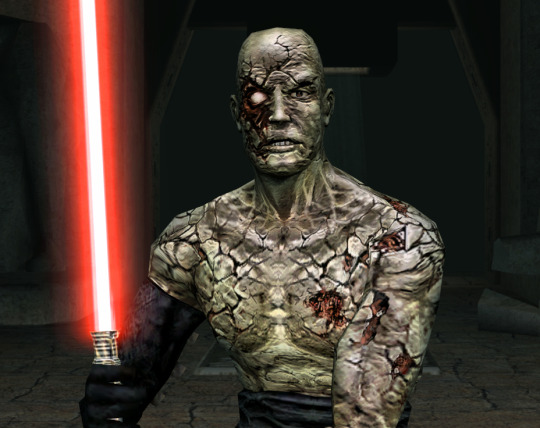
Yeah, that guy. This is when he’s confronting the Exile on Korriban (I know it’s Moraband in the new canon, but this is old canon). We’ll be going into that soon enough.
So, on the surface, SionExile and Reylo have similarities. Sion and Kylo even look somewhat alike.
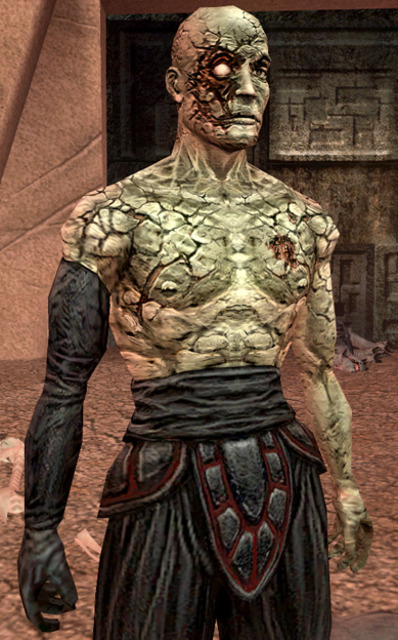
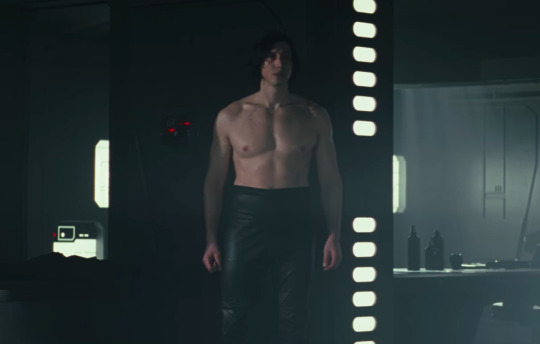
Seriously, I don’t think it’s a stretch to think that they went to the same clothing designer. Difference is that Kylo’s not as seriously scarred, but I digress.
But in the end, there are definite differences in terms of how they’re executed. To begin with, Sion actually seems to care for the Exile, in a very twisted sense of the word. Kylo...if there’s any love in him for Rey, it would be a miracle.
First meetings
For Sion and the Exile, they actually have two first meetings. One is on the Republic ship the Harbinger, when the Exile (along with her two party members, Atton and Kreia -- Kreia being who Sion has a very complex relationship with. He hates her, yet also yearns for her approval, even though it’s clear that she loathes him. And at the same time, he wants to save the Exile -- at least the female Exile -- from suffering the same fate he did, whatever happened to him pre-game) is trying to get off the mining colony Peragus. Sion makes his entrance to the Exile at the end of a long dark hall on the ship (unfortunately, I can’t find a good screencap of it), while saying (at least in the Restored Content mod), “I came to warn you, Jedi; you know not the path you walk.”

Their second first meeting comes on Korriban. Sion’s treatment of the female Exile is quite a contrast to how Kylo treats Rey. While he is rather creepy in terms of describing himself as having studied the Exile extensively (up to knowing where she walked when she was in Exile, her battles in the Mandalorian Wars, and more), he’s surprisingly gentle with her.
For starters, in a video game, the voice acting is essential (along with animation, etc.) to convey emotions. In contrast to his angry Evil Cannot Comprehend Good treatment of a male Exile (Sion doesn’t understand why someone would turn away from power instead of embrace it), Sion is generally tender towards a female Exile in terms of how he speaks. His voice softens, and while there are instances where he seems genuinely confused as to why Kreia would sacrifice herself for the Exile either way, he shows sympathy for what she’s gone through (“You know what it means to be broken.”) and tries to warn her, again, about Kreia and what she’s capable of (”The one who travels with you will destroy you, as she did me. I can end it before it begins.”).
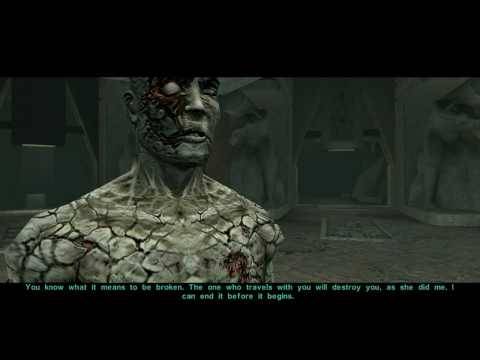
Now Sion, obviously, is not a destined partnership sort. Sion’s not even the character I mainly ship my female Exiles with (that would be Atton, God bless him). But it is noteworthy that even his facial expression seems to be softer in that screencap -- at least as soft as one can get considering the animation. Pretty decent animation for 2004, really. It’s also noteworthy that Sion’s voice goes a lot more tender when he says that line, almost like the Exile’s valuable to him. (We’ll get into that more later)
In addition, he has qualms about harming the Exile. After the Exile (temporarily) beats him in battle, he actually spares her, even ordering his assassins not to harm her. “She,” he says, “Has earned this. She and I will meet again.”
Even that shows more respect towards the Exile than Kylo shows towards Rey. The Exile may be his enemy, but he respects her for what she’s been able to accomplish (especially since, in both paths, he underestimates the Exile. The difference is that with a male Exile, Sion despises him, while with a female Exile, Sion begrudgingly respects what she’s capable of).
In contrast, Kylo’s meeting with Rey is much different. In her initial vision, Rey’s frightened of him:
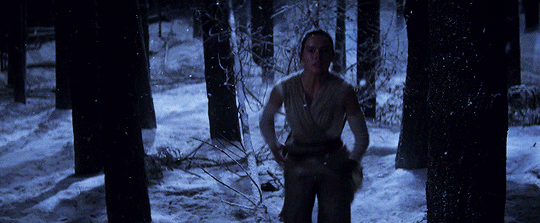
He terrifies her in the forest of Takodana, blatantly:
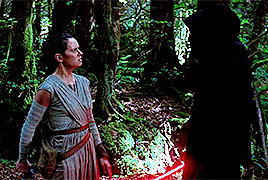

There was quite a ruckus made over the fact that he carried her bridal style (and even that you would have to stretch quite a bit, considering that it reminded me more of how Michael Myers would carry a victim), but even then, the difference between bridal style and that is that you have to have consent from the carried (carry-ee? Who knows). Kylo didn’t have Rey’s consent when he carried her. He actively knocked her unconscious with the Force (it’s rather unclear, but he does wave his hand a little) in order to get what he wanted:
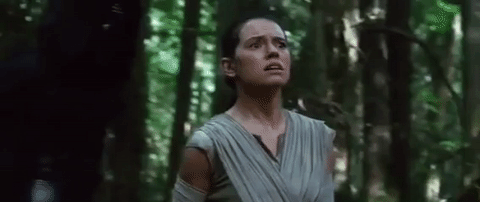
And lest we forget, he tortured her. “But brokenedgeben!” you may say. “You ship Darkpilot, and that’s way worse than Reylo!”
Yes, I ship Darkpilot. The difference is that Darkpilot shippers never try to romanticize Poe’s torture or minimize it like Reylos do with Rey (some have said that Kylo didn’t really torture her). We acknowledge that what Kylo did is a terrible thing and actually try to work with it. Sion obviously never tortured the Exile (ergo, not much to go on), so the best we can do is get into Kylo’s torture of Rey. I remember reading multiple fics that tried to excuse and rationalize Rey’s torture, including saying it was okay because he didn’t use a torture droid on her like he (apparently) did to Poe. But does it really make it better? Let’s really look at the evidence here. Aside from taking off his mask for Rey and trying to explain to her why she’s here, he isn’t really any better towards her than he was towards Poe. In fact, the only difference is that Rey beats him in the end. When he’s interrogating her, and getting into her personal space, she’s crying, closing her eyes, and turning her face away:
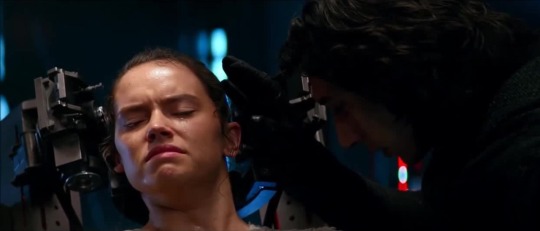
She doesn’t want it. It’s easy to understand why JJ Abrams would compare this scene to a sexual assault -- Kylo refuses to get out of her head and she has to force him out, and then there’s the gratuitous closeness of the two (again, without Rey’s consent, so even if Reylo did exist, it would be one-sided at most) during the torture scene.
Attitudes towards enemies
With Sion, it’s made abundantly clear that he does have compassion and respect towards the Exile, twisted as it is. That only becomes stronger as we get to Malachor V. Nihilus has been vanquished, but Sion and Kreia are still standing, and Sion is relegated to being Kreia’s servant again (after Kreia makes a point of Force Choking him). Now, Kylo had no qualms about bringing Rey to Snoke, and even watches idly as Rey’s tortured by Snoke:
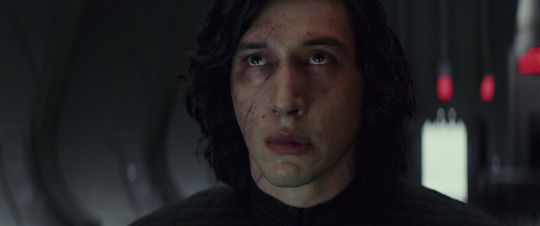
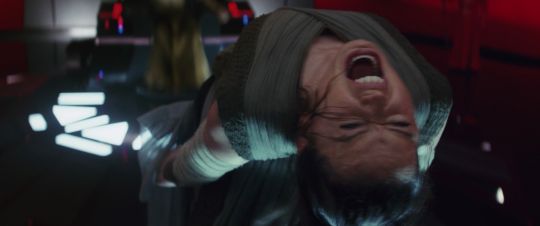
When Rey’s tortured by Snoke, there’s no emotion on Kylo’s face. There’s very little emotion, actually. He does nothing to intervene until the last minute when he kills Snoke (and even Rian Johnson’s comments don’t necessarily suggest that he killed Snoke for Rey). Not to mention that he’s tortured Rey in the past, complete with very creepily getting into her space:

When Kreia and Sion discuss the Exile on Malachor, however, Sion immediately shows concern for her. He explicitly asks Kreia what she will do to the Exile, which Kreia mocks him for, even asking if he has feelings within that shell. (In contrast, aside from Snoke bringing up the idea of Kylo having compassion for Rey in the novelization -- very different from romantic love -- Kylo’s feelings for Rey are never acknowledged onscreen) Even when Kreia explains what she’ll do (which may have been a bluff, but Sion didn’t know that), Sion actually is furious -- he doesn’t show it explicitly, but the gesture he makes of helplessly clenching his fists says volumes, really.
When Rey tries to sway Kylo away from the path he’s going down (and keep in mind she’s crying all the while), Kylo shouts at her, and then, to twist the knife further, forces her to say that her parents were basically nobody and then says, “You have no place in this story. You come from nothing -- you’re nothing. But not to me.” Even the last part could arguably be called a form of emotional manipulation.
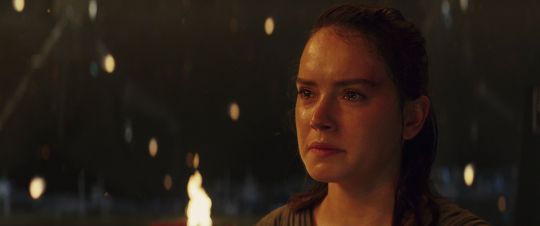
And keep in mind, Rey crying above? Kylo did this to her. All because she wanted to help him.
How does Sion handle the duel with the Exile? He explicitly says that he respects the Exile’s abilities -- twice, actually. “I cannot see as [Kreia] does, but I know that in time, you will surpass her power. But not here. Not [at Malachor].” And “You are strong. As strong as I had believed. But you cannot beat me. [Kreia] knows this.” Part of the last one is sheer denial of the fact that Kreia’s using him as a pawn in a very complicated game of dejarik, part of it is a belief that he’s saving the Exile by either having her leave the Academy or killing her himself. When the Exile tries to help him (albeit in a twisted way, considering that it actually does result in Sion’s death at the end), Sion doesn’t ridicule her. He doesn’t rub in the fact that she’s nothing. If anything, Sion’s words seem to be more of unhealthy twisted coping mechanisms literally trying to keep himself alive. His words are fundamentally turned against himself, while Kylo actively wants to (emotionally) break Rey into joining him.
Think about it. If Kylo really loved Rey, he would have appealed to her joining him by confessing he loved her. Not implying, but confessing. It still would have gotten the point across that Kylo is manipulative, but it would have been a major step up from basically humiliating her and putting her down to make himself feel better about the fact that Luke “chose” her over him (don’t believe me? The novelization explicitly says that Kylo’s jealous of Rey. So was Sion with the Exile, of course, but the waters do get muddied by the fact that he genuinely seems to care for her and worry for her in a twisted way).
First, Do No Harm
During their duel in the forest on Starkiller Base before Rey gets the upper hand, Kylo has no qualms about knocking Rey unconscious to focus on Finn first (it’s only after he severely burns Finn that Rey actually reenters the fight). Does he suggest her joining him? Yes, and in an arguably less derogatory way than he does in TLJ, as he doesn’t focus on her origins as much as her power and potential. That’s actually the catalyst for Rey being able to defeat him, and keep in mind, during her duel, she’s absolutely furious with him (and justifiably so):

(This was the best GIF I got of angry Rey, BTW)
After Rey fundamentally rejects him on the Supremacy, Kylo has no qualms about harming her. He even orders the Falcon blown out of the sky (though he doesn’t succeed or Rey would be dead) by his TIE fighters when Rey shows up to the battle. In contrast, while Sion doesn’t hold back in his duel against the Exile, he repeatedly urges her to surrender and leave Malachor because he sees it as better than what Kreia will inevitably do to her (in his eyes). Johnson could have chosen to have Kylo hesitate in firing on Rey for whatever reason (after all, he had it in the beginning with Kylo refusing to fire on his mother), but he didn’t. He chose to have Kylo treat Rey as any other opponent he hated.
The Confession
While Kylo never really confesses his feelings to Rey explicitly, some Reylo shippers have interpreted the “you have no place in this story” speech as a love confession simply because of Kylo’s “but not to me” at the end. The problem is that it doesn’t do anything to tie into Kylo’s character; it’s just awful. In contrast, Sion’s confession is...probably not going to win any awards for best confession ever, but it ties into his character organically and is unexpectedly poignant because it is basically Sion trying to comprehend feelings that aren’t simply the hate and anger that’s keeping him alive -- feelings that may literally kill him. Even the script directions for the dialogue (shown on this Wookieepedia page if you scroll to the bottom and look for the eleventh footnote) describe it as him trying to describe what love feels like to him. It’s part of his character and makes sense. It illuminates a part of his character. With Kylo, the “you come from nothing” speech could have been intended to serve a similar purpose, but what does it really reveal about him? Nothing, except him being a manipulative bastard. And Sion/Exile was never intended to be a destined partnership (those would fall to Atton/Exile and Disciple/Exile, respectively, for a female Exile. And possibly Visas/Exile and Handmaiden/Exile if you’re using a mod). It was all part of Sion’s character, not knowing what to do with his emotions that aren’t hate.
Even while he’s dying, he doesn’t lose his affection for the Exile. He even, while warning her about Kreia a final time, says, “Her weakness is you. As you were mine.” Coming from the literal embodiment of the Dark Side, that’s actually touching in a way.
A tale of two heroines
What also makes Sion and the Exile work is purely in a character-driven way -- Sion is a look into what the Exile could have become if she depended too much on the Force/fell to the Dark Side. (Nihilus is a more blatant parallel, but Sion definitely has his parallels too) The Exile keeps her character arc; she isn’t sacrificed identity-wise in order to try and save Sion. All throughout her encounters with Sion, she keeps her identity intact. And keep in mind, this was written in 2004.
In contrast, everything about Rey’s character in The Last Jedi is sacrificed to serve Kylo. She’s willing to put herself in danger on the off chance (and a really forced -- if you pardon the pun -- off chance that there may be good in him). Luke had a more familial version of it with Vader, but he kept his character arc of becoming a Jedi intact. Rey is sacrificed to serve another, her story of becoming a Jedi ultimately consumed by Kylo’s story. And this was in 2017. And called a “feminist” film. Calling it feminist is a genuine insult to feminism.
Does Rey get a chance to resolve her own conflicts? No. She’s relegated to resolving another’s conflict. When she confronts Snoke, it’s all about “Ben”, not resisting the Dark Side herself. Rey rarely gets a chance to have an identity of her own in TLJ until towards the end; it’s all about Kylo. But hey, what do I know? Obviously I hate things directed at women, despite being a woman myself.
Conclusion
When a hero/villain relationship keeps the heroine’s agency more in a game written in 2004 than a movie in 2017, we’ve got problems on our hands. Even saying that KOTOR II was a deconstruction is no excuse, as The Last Jedi was a deconstruction as well. (I’m probably going to stir up some controversy considering that apparently KOTOR II and TLJ are Friendly Fandoms, but TLJ doesn’t even hold a candle to KOTOR II) The difference is that one got it right, and the other got it wrong. One defied sexist tropes, one succumbed to it. One made the villain sympathetic and even redeemable through the relationship, the other did not.
So how would I have written Reylo? I wouldn’t have copied Sion/Exile word for word, but I’d take these lessons to heart:
-Emphasize the nature of Rey and Kylo as foils. Using Kylo as a foil for Rey would have arguably saved Rey’s character from becoming just a tool for Kylo, as she would have faced him in a way that was relevant to her becoming a Jedi in her own right. Even if you didn’t have her lose in the forest on Starkiller Base, she could be learning to resist the Dark Side, or at least struggling with it. You could even have her struggle with Luke’s teachings, at least in terms of what she’s learned.
-Cut the whole matter of Kylo ragging on Rey’s origins. It really does nothing except make him look like a pointless jerk.
-Have Kylo actually show he cares for Rey. There were countless opportunities. He could have hesitated to blow her out of the sky on Crait. He could have expressed sympathy towards her parentage (even though he has no idea what she’s gone through, at least he’d be trying). He could have openly used his caring for her in order to get her to join his side. (Think Bastila with Revan) He could have warned her what Snoke would do to her and that she shouldn’t have come (though that would have gotten in the way of his plan to turn her, so there is that. Mostly suggesting, of course).
-Build up to Rey actually caring for Kylo and wanting to save him. There was no transition to her sudden change of mind, not even a bit of foreshadowing. It makes me wonder if a scene got cut that never even made it into the deleted scenes.
-Completely change the “You come from nothing” scene. Instead of having Kylo use Rey’s parentage against her, have him promise her a future -- a better future, in his eyes, than what she’s got.
-Have Kylo try and warn her about Luke. It would have been a nice bit of foreshadowing for the fact that Luke’s not entirely the good guy.
-Make it unique to their characters. Make it part of their individual arcs (as I would argue that Sion got an arc despite not being a party member). Make it unique and striking, and you can likely get some gems from there.
In the end, Reylo could have been a lot more. Rey could have been a lot more. The fact that a game made in 2004 had better writing, character development, feminism, and emotion than a movie made in 2017 really does say volumes about how Star Wars has evolved -- and how it may go in the future.
#anti reylo#or at least as it's written#rey deserves better#tw: torture#how kotor 2 was ultimately better than tlj#2004 feminism vs 2017 feminism#2004 feminism wins#meta
3 notes
·
View notes
Text
June 7: Going through the Smash E3 Trailers
Well, the title says it all. How to best predict or understand what we might see on Tuesday? Look at the history. I should note I’ll be ignoring Melee, as the nature of how information on it came out (and how people reliably accessed it) makes it more of an outlier.
E3 2005: A new Super Smash Bros. game for the Wii, then-called Revolution, is announced.
E3 2006: The first trailer for what is now named Super Smash Bros. Brawl releases.
youtube
Veterans: Mario, Link, Pikachu, and Kirby - four of the five main Smash fighters. Samus is also shown, albeit in a way that doesn’t confirm her inclusion in her classic form.
Meta Knight (Newcomer): One of the most popular characters requested, Meta Knight follows Peach as the first newcomer revealed and part of a franchise already represented. You can also argue his placement references his (and the Halberd‘s) involvement in “The Subspace Emissary.”
Pit (Newcomer): Another highly requested character, filling the Ice Climbers’ role as an iconic retro hero. Notably, he also sports a drastic redesign.
Zero Suit Samus (Newcomer): ZSS was probably never anyone’s most wanted character. However, her inclusion is necessary; she obliquely represents the new Final Smash mechanic.
Wario (Newcomer): Outside of Sonic, Wario probably was the most wanted character - but fans assumed he would use his classic costume. This shows he will be fighting as a wildly new fighter, one who represents a sub-series that started after the release of Melee.
Snake (Newcomer): Shocking everyone, the last reveal is of, for the first time ever, a third party character into the battle, and one no one would have rightly expected. Snake’s inclusion sparks a change in the Smash community where previously laughable, mocked suggestions can “potentially” be plausible.
Alongside characters, we also see new, unnamed stages: Battlefield, Halberd, Castle Siege, Pokémon Stadium 2, Skyworld, Mario Circuit (Brawl), and Yoshi's Island (Brawl) (Shadow Moses Island would be revealed in accompanying screenshots). A Nintendog hints at the new Assist Trophy item. And we see incredibly “super attacks,” later dubbed Final Smashes, which fighters can acquire by collecting a ball with the Smash logo.
E for All, 2007: While not part of E3, this is the period in which the public is allowed to play a demo for Brawl, featuring Sonic the Hedgehog - who had been revealed only eleven days prior. As for E3 itself, 2007 has a fifteen second video revealing only Donkey Kong. I’m not going to highlight it here for space.
E3 2011: A new Smash Bros. game is announced, which will appear on both Nintendo 3DS and Wii U.
E3 2013: The first trailer and sizable accompanying information for what is now named the collective Super Smash Bros. for Nintendo 3DS & Wii U are released during a Nintendo Direct.
youtube
Veterans: Mario, Link, Samus, Kirby, Fox, Pit, Donkey Kong, Pikachu, and Bowser.
Villager (Newcomer): while Villager’s chances and popularity were debated and debatable, Animal Crossing is a huge franchise for Nintendo. Using him to almost literally lead off the cast makes sense.
Mega Man (Newcomer): A new precedent is set: unlike with Brawl, newcomers to Smash For (excluding clones) were given individual trailers. Having Mega Man’s be the first makes sense; he was possibly the most requested guest fighter after Sonic.
Wii Fit Trainer (Newcomer): Unlike the other newcomers, Wii Fit Trainer - the game’s new surprising, out of nowhere fighter - is now revealed in the Direct itself but on the show after the fact. Her reveal comes at a demonstration in which Sakurai plays a match, and before a video of him discussing the game’s ideas is released.
Altogether, we see extensive information from those trailers. New stages are later revealed to be Battlefield, 3D Land, Gerudo Valley, Spirit Train, Skyloft, Arena Ferox, Living Room, Boxing Ring, Town and City, Wii Fit Studio, and Wily Castle. Of noteworthy shots, one is of a jungle-esque stage, and the other is a platform-less version of Battlefield; in an April 2014 Smash-centered Direct these would be revealed as part of Smash Run and an Omega Form, respectively. Finally, one CGI scene shows Mario followed by five other fighters on Battlefield, arguably hinting at the Wii U version’s Eight-Player Smash mode.
E3 2014: Attention ahoy. You’ll note that this isn’t a trailer; instead of taking up one part of the Direct, Smash bookends Nintendo’s (rather good) showing.
youtube
Mii Fighter (Newcomer): The Miis were no one’s favorite choice for a character, but they excite because they introduce to the series the ability to actually customize your own fighters - a godsend in a series beloved and notorious for how wide its breadth of inspiration reaches. This also dovetails with the end of the show, in which Palutena, the newcomer and only other fighter whose special attacks vary wildly like them, closes out the event.
Pac-Man (Newcomer): Pac-Man is unveiled at a private showroom after a massive Smash Bros. invitational tournament, one in which sixteen competitive fighters play on a build which would later be available to E3 attendees. The invitational itself provides some information that had been revealed and clarifies other points, from how certain Assist Trophies function to the utility of different items.
E3 2015: While Nintendo does not feature Smash in any capacity during its Direct and only minimally during its post-show “Treehouse Live at E3″ segments, they announce and release a wealth of downloadable content for Smash For. Lucas, announced months prior, is released alongside fellow veteran Roy and newcomer Ryu, from Street Fighter.
youtube
So...what can we take from this?
Well, I think it says a few things. Mostly, the newcomers shown off will be fairly big in terms of fame and popularity. I know that seems insultingly obvious, but it’s true. A third party fighter especially seems likely; if the game really is coming out this year, it makes sense to show any and all they can. Like, I feel like if Ridley is coming to Smash, showing him off here seems the smartest, given his colossal popularity, instead of on the side or as an unlockable fighter.
I think it’s also interesting how some are chosen. Of all the newcomers, only three - Meta Knight, Zero Suit Samus, and Palutena - came from prior series. And of those, Meta Knight’s the only one whose entire design isn’t tied to a mechanic introduced in that game. This isn’t to say they’re not going to appear here at all, just that most likely we may see new series represented.
Those two fighters lead me to something else: there will very likely be mechanics, items, powers, or modes the trailers will obliquely show or reference without explicitly saying. I do suspect that those 2005 and 2013 trailers deliberately hinted at the story mode and Eight-Player Smash, respectively. So while most crazy theorizing will be just that, maybe you will stumble upon or uncover something that’ll turn out huge.
However, this also says we should not put all our stock in only this showing. In an interview today with the Hollywood Reporter, Bill Trinen admitted that they will be keeping some Smash surprises for after the event. It shouldn’t surprise anyone; this series has never been one to show all its cards. So be excited, hope for more stuff, but also remember that this won’t be the be-all and end-all of this new iteration. All of these videos only prove how no matter how much information we get, so much can, and will, be hidden.
Also, as a minor point, it’s likely that Smash may not be relegated to just one section of the event. I suspect it’ll both start and end it, the way it was in 2014. As important as this game is for Nintendo, they have other stuff to show. Pokémon Let’s Go is a big deal, there’s potentially Fire Emblem for Switch (and other announced games in development), there’s the increasingly inevitable announcement of Fortnite; they may have a lot on their plate (one rumor says it might be upwards of forty-five minutes - which is apparently about twice as long as the fairly packed one last year).
But finally, just remember that all of these are nothing more than precedents and commonalities. A lot of Sakurai’s general directions here make sense, but we don’t know if he’ll be using the same kind of character trailers the last game(s) did or going back to the Brawl “general stuff” kind of trailer, or something entirely different.
(Link to my writings on Smash Bros for Nintendo Switch)
5 notes
·
View notes
Text
Skyline X Drone – Scam, Price, Features + Benefits
Skyline X Drone Reviews, the new Skyline X Drone Pro takes your Photos and recordings to another level, explicitly intended for simple flying. Robots are costly, correct? That is one of the huge downsides for when you need to buy one, yet who says they must be an expensive buy. As the tech progresses every year, it's getting less expensive and less expensive to make excellent robots that function admirably. Is Skyline X Drone one of those?

What Is the Skyline X Drone?
Skyline X Drone Reviews separates itself as a moderate robot alternative. Such countless robots these days are really costly, evaluated way out of the spending plan of the vast majority. The creators of Skyline X Drone, however, needed to ensure that most every individual who needed a robot could bear the cost of one, so they set to work creating what might turn into the Skyline X Drone Pro.
A great deal of the Skyline X Drone audits will discuss how this is a spending agreeable choice for individuals who need a robot, however it is more than that. The originators have attempted to make it a solid, completely included robot that can tolerate toeing to toe with a portion of the robots that expense many dollars. Did they prevail in that favorable objective? How about we discover.
➦➦ Special Discount: Order Today With Best Price And Special Offers ➦➦
How Skyline X Drone Works?
This is a short reach drone that works through controller. You can watch a live feed video of what the robot is seeing, which can help you control it better when it escapes visual reach. The flight time isn't particularly long, so you might not need to stress a lot over it escaping sight, and the reach is around 100 meters most extreme.
At the end of the day, this is a short-range robot, and you shouldn't anticipate that it should fly for extensive stretches of time, at high heights, or in breezy climate. It is a basic, moderate robot that is intended for light flying in good conditions.
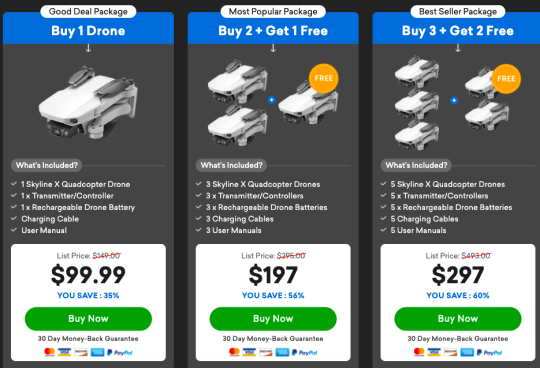
A couple of AA batteries power the robot, which gives you a thought of how much force it offers. It will actually want to get pretty high, yet not rapidly. This is to a greater degree a toy drone than something you may use for proficient recordings or for a renowned YouTube channel. It's for amusement and an extraordinary redirection, yet the quality and value make it a decent venturing stone to further developed robots, when you can bear the cost of them.
Skyline X Drone Technical Specifications
How about we take a gander at the Skyline X Drone Pro specs for this robot, giving you a thought of what it can do and a fast once-over of its abilities so you can undoubtedly contrast it with different robots.
• Can fly for as long as 10 minutes-pretty norm for this sort of robot
• Uses a 3.7v 600 MAh battery
• Range-between 50-100 meters
• Includes 720p camera
• Live video feed
• Offers numerous flight modes

➦➦ Special Discount: Order Today With Best Price And Special Offers ➦➦
The Features the Skyline X Drone Offers
All in all, how would this be able to ramble respond? The Pro X robot is viewed as superior at its cost section, which means it offers a couple of extraordinary highlights and some incredible flight abilities that you probably won't expect at this value point. One of the vital highlights of the Skyline X Drone is the keen flight choices it offers. It can hold its elevation, so it stays in a single spot.
That is extraordinary for ethereal survey through the camera, permitting you to get a fixed video feed for oversight, recon and elevated photography. Savvy flight considers hands free flying as well, and that is ideal for individuals who need to attempt various types of robot flying. You can even cause it to do 360° flips with the press of a catch, which is truly cool. This is an extraordinary robot for flaunting to your companions.
The camera is good at the cost, yet it is not much. It has a live feed alternative and can take OK recordings, yet these are not expert evaluation, using any and all means. It offers voice control as well, which is truly slick. Having the option to instruct the robot and where to go is anything but a typical component of your commonplace robot, considerably less one that retails at the low Skyline X Drone Pro cost.
Skyline X Drone Pros and Cons
I need to cover the benefits and impediments of this audit. It's significant that you understand what you are getting and think pretty much every one of the drawbacks just as the advantages of purchasing this robot. Not the entirety of the Skyline X Drone audits will cover the great with the terrible, yet you need to know this stuff before you purchase.
PROS:
• Includes a camera
• Offers numerous flight modes
• Responds to voice orders
• Great value point for what it offers
• Can flip at the press of a catch
CONS:
• Very restricted flight range
• Short flight time

➦➦ Special Discount: Order Today With Best Price And Special Offers ➦➦
The most effective method to Use the Skyline X Drone!
An incredible aspect regarding the Skyline X Drone is its basic activity. It is anything but a muddled machine to utilize, so the vast majority will get the hang of its controls rapidly, I think. This is certainly a novice agreeable item, and you'll see that for yourself once you check it out.
To work it, you first need to introduce the AA batteries. At that point, simply turn on the robot and utilize the straightforward controls to get it airborne. Keep in mind, this robot can balance out at a particular elevation, and it is intended to have incredible soundness, as long as the climate is reasonable. Make a point not to fly the robot in unfavorable climate, similar to high breezes, downpour or snow. It essentially isn't intended for harsh climate flight, regardless of whether it may hold up the initial not many occasions you bold the awful climate with it.
You additionally need to be certain you cling to nearby robot flying guidelines, such as getting your robot far from air terminals and other confined territories. At the point when you are finished with the robot, make certain to overlap the cutting edges up and bundle it securely to guarantee it doesn't get harmed. It packs tiny so it tends to be taken pretty much anyplace. To ensure it stays safe, attempt to store it in the first bundling or purchase a convey case for it to defend it during transport.
Who Should Buy the Skyline X Drone?
The low Skyline X Drone cost and the capacities of the item appear to highlight a particular sort of client the kind of purchaser who needn't bother with a superior robot and who has a restricted spending plan to work with. This isn't the sort of robot that an expert may utilize, however it is surely an extraordinary robot for plunging your toes into this pastime and checking whether it very well may be for you. On the off chance that you need a greater number of highlights than your actual essential, efficient robots yet you can't stand to pay many dollars, at that point you should allow the Skyline X Drone an opportunity, since it is presumably made for you.

This is likewise an incredible robot for individuals who need to fly a robot in a local location where they probably won't have a great deal of room for flying. The Skyline X Drone reach is very restricted when contrasted with all the more remarkable and more costly robots, coming in at around 100 meters or less. Its reach relies upon a portion of the conditions at the hour of flying, so remember that, however this is definitely not a long reach drone.
In the event that you like photography or videography as a diversion, I would say that the Skyline X Drone is for you also. This is a nice little Drone for taking recordings, and keeping in mind that they may not be super superior quality in quality, it does the work really well. You can make some astonish recordings with this robot, taking it up many meters into the air for precarious shots you would not have the option to get something else. Obviously, the recordings are quite astonishing as well, as it can record its way through the air and get you staggering video from unbelievable points you haven't seen before in your recordings.
➦➦ Special Discount: Order Today With Best Price And Special Offers ➦➦
Last Verdict
Would it be advisable for you to purchase the Skyline X Drone or not? My take is that this is a decent arrangement, particularly on the off chance that you discover it for under $100. It's uncommon to discover quality robots for not exactly that, so I would say hop on this while it is being offered so moderately. Swelling will drive that cost up on schedule, and you should exploit the offer while it is accessible. This is a shrewd purchase for anybody needing a reasonable robot, however it is additionally very sturdy.
The producers utilize great materials that guarantee this robot endures and that it can deal for certain knocks and scratches and still continue going, so that is outstanding at the cost point. Additionally remember that you can get a good deal on this robot on the off chance that you purchase more than each in turn, which you might need to do on the off chance that you are getting it as a blessing and you need one for yourself.
The Skyline X Drone cost is perhaps the most appealing highlights, yet you ought to likewise remember that it has a camera and an assortment of brilliant flight modes. This isn't only a basic robot where the producers are attempting to make a speedy money get. You can tell that some idea and care has gone into its plan to guarantee it has the most mentioned highlights for a seriously evaluated drone.

In the wake of perusing this Skyline X Drone audit, I trust you feel more educated about this minimal expense alternative that a many individuals are testing. I figure you will be agreeably astounded on the off chance that you check it out yourself, and I'm suggesting it for anybody on the lookout for a spending drone that performs well.
0 notes